A Short Story of Narama's Long History
The history of Narama and its surroundings from prehistoric times to the present day in brief
Introduction
The village and administrative district of Narama is currently located in the Lesser Poland Voivodeship, in Kraków County, within the municipality of Iwanowice. It is home to approximately 2,000 residents. Geographic coordinates: 50°10′49″N 19°56′02″E. The distance from Narama to Kraków is about 10 km. The first written mention of Narama dates back to 1360. It is possible that Narama is even older than the 14th-century sources referring to it. Some suggest that the origins of Narama might be traced back to the times of the Great Moravian State. Perhaps this is true, but access to such records is currently very limited. In the future, when the most valuable collections of Kraków's ecclesiastical and civil archives are fully digitized, they may become more accessible. For now, we must focus on the materials available to us, as there is already a wealth of primary sources!
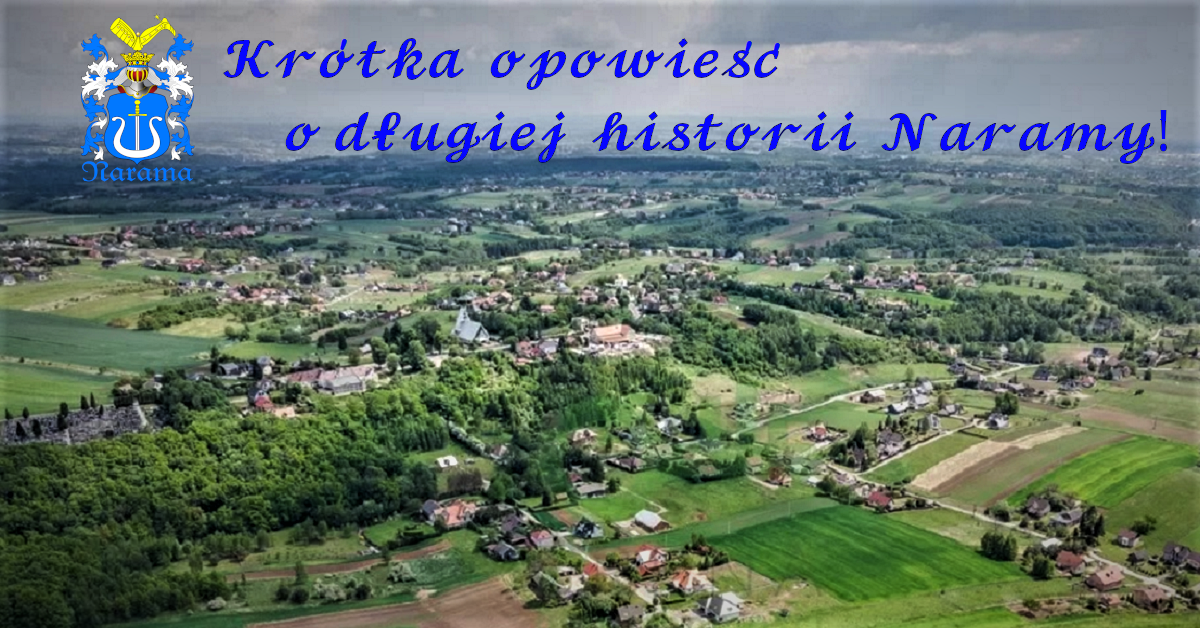
In the photo: A panoramic view of the center of Narama. Drone photography.
The online portal (“Narama Yesterday and Today”) provides contemporary news, useful and necessary for the residents of Narama. The website also features historical content in the form of short historical sketches as well as extensive studies discussing specific events from Narama’s rich history or describing important figures, including the owners of the Narama estate.
Below is a brief historical sketch of Narama. We suggest that interested individuals translate the texts themselves. This is particularly important for people with surnames such as Naramski, Naremski, Narembski, or Narębski, as their ancestors bearing the "Nowina" coat of arms undoubtedly originated from Narama.
A Long Time Ago
The southern areas of the present Kraków-Częstochowa Upland, including the Prądnik Valley, have been inhabited for hundreds of thousands of years. Natural residential structures such as caves and rock shelters, abundant flint resources, and the varied terrain offering excellent defensive conditions attracted humans to these areas as early as the Paleolithic period (Old Stone Age). Evidence of this includes discoveries in Ojców and its surroundings.
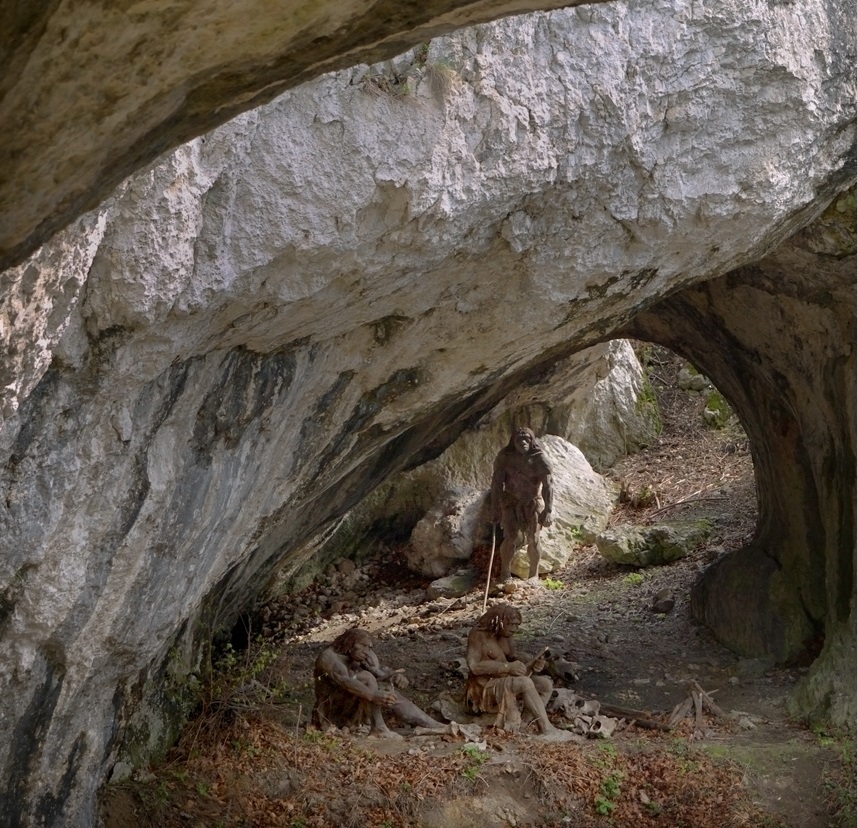
In the photo: A reconstructed Neanderthal camp in one of the caves near Ojców.
In Narama, there are nine archaeological sites from the Neolithic period in Central Europe (information recorded in the study “The Municipal Program for the Protection of Historical Monuments in the Municipality of Iwanowice for the years 2014-2017”). Archaeological sites from this period are not only found in Narama but also in the surrounding areas (e.g., Ojców, Iwanowice, Sąspów, etc.). These sites include mines and stone workshops, particularly for flint, which was used to make tools and start fires.
The history of Kraków Land, the city of Kraków, and therefore Narama—located near Kraków—is somewhat different from other regions of Poland, especially the Polan Duchy and its ruler, Mieszko! The later "Kraków Land" is synonymous with the earlier territory of the medieval Slavic tribe known as the “Vistulans” (Wiślanie). Christianity existed in this region at least 100 years before 966 AD, when Mieszko, Duke of the Polans, was baptized.
After Kraków Land was incorporated by Bolesław the Brave, Kraków, the former capital of the Vistulan state, became the seat of a bishopric. Over time, it evolved into the capital of the powerful Polish-Lithuanian Commonwealth (which included today’s countries of Poland, Lithuania, Belarus, Ukraine, parts of Latvia, Estonia, Moldova, the Spisz starosty in Slovakia, and the Smolensk principality in Russia).
Curia militaris Narama or the Military Settlement of the Nowina Family (until 1625).
The origins of the village of Narama are linked to the history of the noble family bearing the “Nowina” coat of arms. According to historical accounts, one of Poland’s prominent dukes, Bolesław the Wrymouth, granted the “Nowina” coat of arms to one of his warriors in 1121 for saving his life in battle. Since the warrior was responsible for guarding the cauldron in which food was cooked at the military camp, the coat of arms features a cauldron handle and a sword. As the warrior lost a leg in battle, a golden armored leg also became part of the coat of arms.
The name of the village Narama comes from the medieval name Naram, which was common at the time. In the Slavic language, the name Naram referred to someone who was mighty, tall, and possessed exceptional strength.
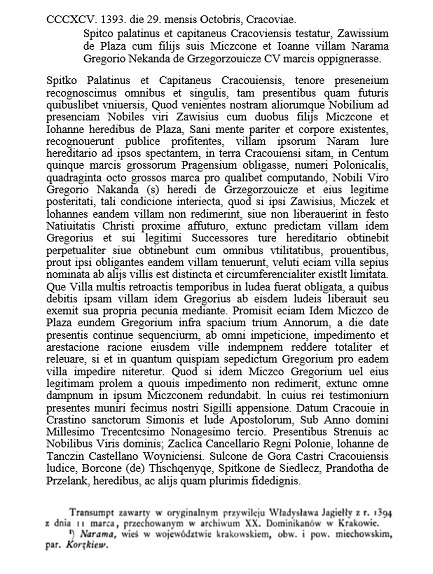
In the photo: A transcription of a 1393 agreement made before the Kraków Land Court between the owners of estates in Narama.
From the name of the village, a branch of the "Nowina" family that lived and managed property in Narama adopted the surnames Naramski, Narembski, and Narębski (indicating they came from this village; for example, in Latin, it was written as Andreas de Narama, and in Polish, as Andrzej Naramski). The village was originally recorded as "villa Narama." Unfortunately, during this period, there was significant variability in the spelling of place names and surnames, so when the name of the village was modified, the spelling of the estate owner's surname was often altered as well.
The earliest discovered written records referring to Narama are dated to 1360. More information about the village can be found in the records of the Kraków Land Court, established around 1374. These documents reveal that different parts of Narama (peasant farms) were owned by various noble proprietors who actively managed their estates.
For example, in 1388, Jan of Narama leased the peasant Paweł's farmland in Narama to Grzegorz of Grzegorzowice for 9 grzywnas and 8 skots. The records indicate that years earlier, Narama "was pledged to a Jewish woman," but Grzegorz redeemed it with his own funds in small payments. In the following year, Jan of Narama and Fenka, Jan's sister and the wife of Tomek of Przybysławice, renounced all claims to their holdings. Grzegorz of Grzegorzowice then pledged the village of Narama for 105 Prague groschen to the heirs of Zawisza Płaza of the Topór coat of arms and his two sons, Miczka and Jan. If the pledge was not redeemed by Christmas, the village would pass into Grzegorz's ownership.
In 1394–1395, Ratołd of Zagórzyce entered the dispute, challenging Grzegorz of Grzegorzowice over ownership of property in Narama (specifically, a garden and a tavern). In 1394, Jakusz, known as Ciszyc, with the consent of Czcibor and Piotr's sons, sold his share of Narama to Grzegorz of Grzegorzowice for 16 grzywnas.
For context, during this period in Poland, the price of a bull was approximately 30 Prague groschen, a horse about 300 groschen, peasant shoes 4 groschen, a ram 8 groschen, a bow 8 groschen, a crossbow 60–120 groschen, full plate armor 475 groschen, a chicken 1 grosz, half a barrel of beer (1/2 achtel) 8 groschen, the cheapest helmet 144 groschen, a sword up to 70 groschen, a dagger 8 groschen. One łan (a measure of land) in Pyzdry was sold for 192 groschen, and a stall in Przemyśl for 960 groschen. A Bible cost 30 Kraków grzywnas, equivalent to 1,440 Prague groschen.
Between 1407 and 1411, Heldwig of the Nowina coat of arms, who identified himself as being from Marszowice, Przybysławice, and Narama, settled accounts with all co-owners of the estate, becoming the sole proprietor of all of Narama before his death in 1413.
After Heldwig's death, Narama passed to his heirs (sons and daughters). One of the most notable was Jan Połukopek (Połucopek) of Narama of the Nowina coat of arms, the husband of Jagienka of Bodziejowice and brother to Imram, Spytek Połukopek, Zbyszko, Andrzej, Dziersław, Małgorzata, Katarzyna, and Anna. Jan Połukopek died in 1441.
From 1442, the main part of Narama was owned by Andrzej Połukopek of Narama (Naramski), of the Nowina coat of arms (died 1471), son of Jan Połukopek, brother of Katarzyna (wife of Jan Orlasz of Mniszów), husband of Anna, daughter of Tomasz Pszonka of Więcławice, and father of Jan, Bernard, Walenty, Stanisław, and Dorota (wife of Stanisław Skierka of Szczodrkowice).
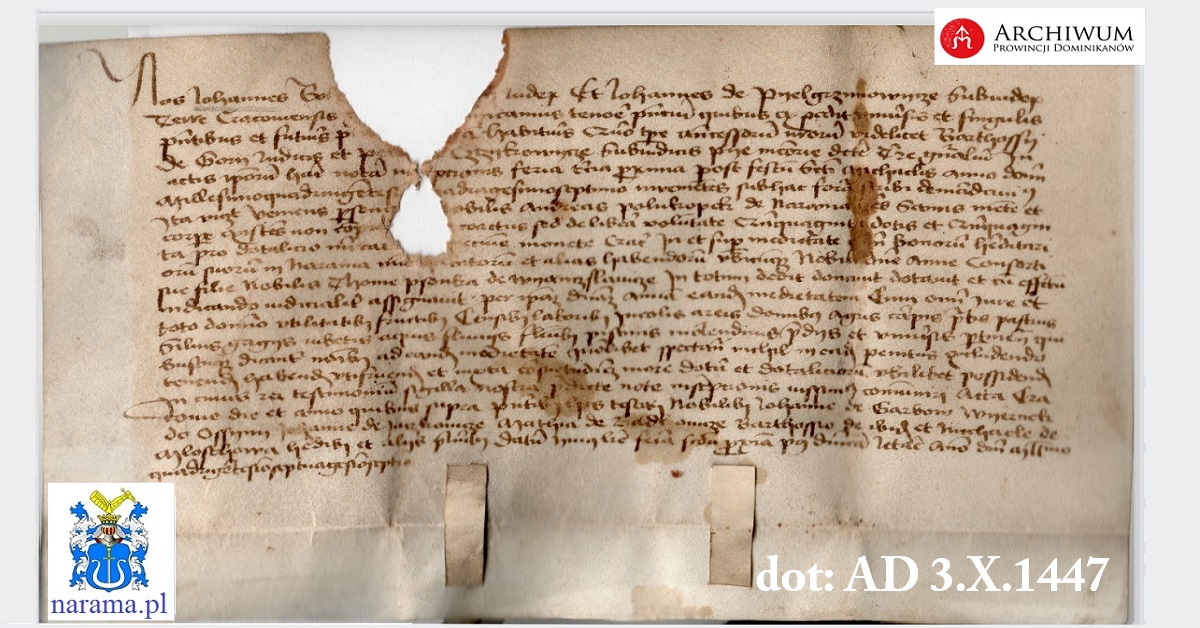
In the photo: A scan of the original document from March 17, 1477, in which Judge Jan Bohun and Kraków Deputy Judge Jan of Pielgrzymowice certify that on October 3, 1447, Andrzej of Narama granted his wife Anna 50 grzywnas in silver as a dowry and secured an additional 50 grzywnas on half of his estate in Narama.
In 1470, Narama and its owner, Andrzej Połukopek of Narama (Naramski) of the Nowina coat of arms, were mentioned in the chronicle of Kraków canon Jan Długosz (Ioannes Dlugossius; Longinus) titled “Liber beneficiorum dioecesis Cracoviensis.” It was described as a "curia militaris,” meaning a military settlement or structure, whose owner was “Andreas Naramsky, nobilis de domo Nowina.” (Et primo habet decimam manipularem in Narama sub parochial ecclesiae de Korzkyew sita, cuius haeres Andreas Naramsky, nobilis de domo Nowina. Item est ibi una curia militaris. Item est ibi una curia militaris quae de agris suis praedialibus decimat plebano et ecclesiae de Korzkew.)
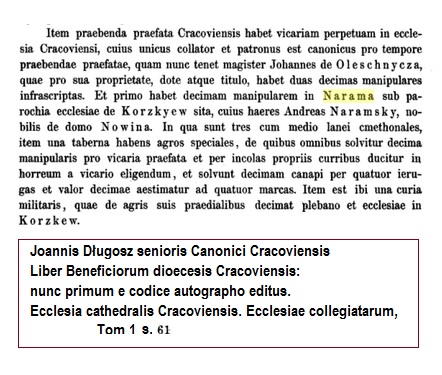
In the photo: Mention from "Liber beneficiorum dioecesis Cracoviensis" (The Book of Benefices or The Book of Collections of the Diocese of Kraków) compiled by Jan Długosz in the mid-15th century.
After the death of the aforementioned Andrzej Połukopek Naramski (Andreas Naramsky, nobilis de domo Nowina - now the patron of Narama Square), which occurred in 1471, his inheritance was taken over by his sons Bernard, Jan, Walenty, Stanisław, and his daughter Dorota. At the same time, Stanisław Narębski of Narama became the heir of Rudno Wielkie, Szczodrkowice (Smardzowice parish), and Garlica Dolna (modern-day Górna Wieś). He was the husband of Beata, daughter of Mściwoj of Wyszogród (d. before 1530), widow of Zygmunt Zagórski, who went missing during the Moldavian campaign, and the father of Stanisław, Jan, and Mikołaj, heirs of Garlica Dolna (Górna Wieś), Rudno Wielkie, and Szczodrkowice. Stanisław acquired these estates through his marriage to Beata.
The "Moldavian campaign" under King Jan Olbracht is mentioned because the owners of "curia militaris Narama" were knights serving the ruler of the Polish-Lithuanian Commonwealth. As such, when the King of Poland and Grand Duke of Lithuania, Rus', Prussia, etc., waged war, they were obliged not only to participate but also to properly arm themselves and their subordinates. The Moldavian campaign ended in disaster. It could have ended badly for Walenty Naramski, one of Narama's heirs, as in 1498, the royal court bailiff informed the "noble" Walenty Naramski, co-heir of Narama, that he was no longer its heir. Due to his failure to fulfill the obligations for King Jan Olbracht's 1497 Moldavian campaign, Piotr Chlewiski, cupbearer to Prince Zygmunt (later King), who participated in the campaign, was granted Walenty's Narama estate.
Terrified, Walenty defended himself against the confiscation of his estate in favor of Piotr Chlewiski by arguing in court that he was not obliged to participate in the campaign because he was in an undivided estate (i.e., the property had not been partitioned) with his brother Stanisław, who fulfilled the campaign obligations on behalf of the estate. The royal court ruled that Walenty had to take an oath with two credible witnesses, who had not been his dependents for three years, affirming his undivided status. Later documents reveal that Walenty Naramski successfully proved he was only a co-owner of the estate and that his brother Stanisław had fulfilled all obligations on behalf of the estate. Walenty Naramski married Katarzyna, daughter of Florian of Wilczkowice, and died in 1527.
In 1521, Stanisław Narębski of Garlica and Szczodrkowice leased his patrimonial and maternal estates, along with those of his brothers (they were undivided)—Andrzej, Jakub, and Mikołaj in Garlica Górna and Rudno—to Paweł Wroniński of Rudno Górne for three years, including livestock, swine, and household equipment. As part of the lease, Wroniński owed Narębski 45 grzywnas, 9 of which were to be paid to the Kraków Cathedral vicars, with the remainder to be paid within three years. Narębski committed to protecting Wroniński from any claims made by his brothers.
In 1525, the undivided Andrzej and Jakub Naramski of Narama and Rudno (Górne) agreed to pay Paweł Wroniński 200 florins as a dowry for their sister Katarzyna, under the threat of her receiving their inherited share in Rudno Górne as compensation.
In 1529, Stanisław Narębski pledged his entire inherited shares in Narama, Rudno Górne, and Szczodrkowice to Paweł Wroniński for 100 florins. In 1539, Stanisław Narębski borrowed 130 florins from Jakub Będuszowski, offering Narama as collateral. In 1543, he repeated this by borrowing 240 florins from Andrzej Dłuski, again guaranteeing repayment with Narama as collateral.
In 1581, Stanisław Narębski (Naramski), a descendant of the aforementioned Stanisław, divided Narama into two equal parts and distributed them between his sons, Stanisław Jr. and Jan. Both brothers were required to compensate their sister Dorota, wife of Paweł Szydłowski, Kraków’s burgrave, from the estate. Their joint grave was located in the now-lost Church of St. Michael on Wawel Hill.
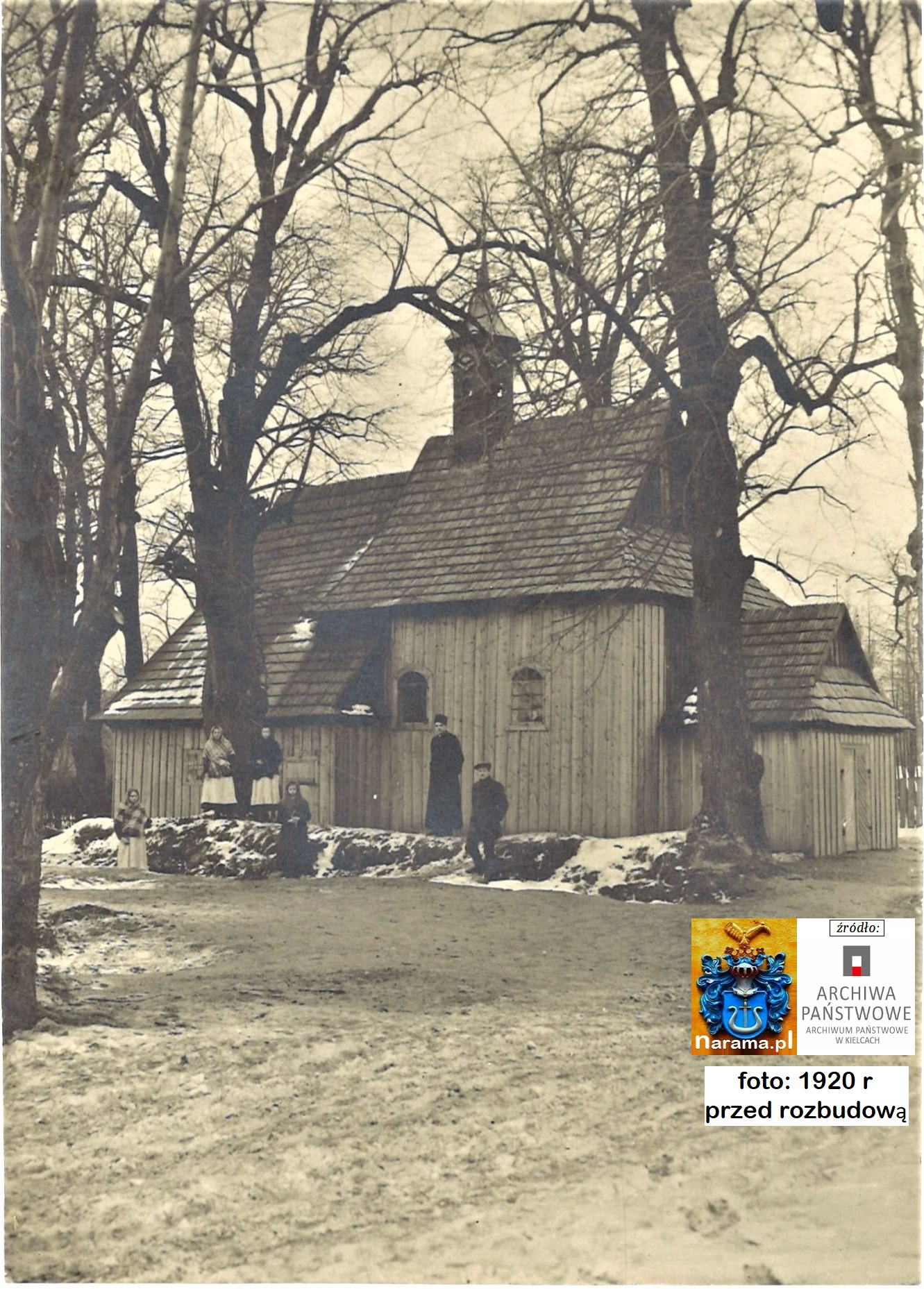
In the photo: View of the church built in 1617 from funds provided by Paweł Żydowski, owner of half of the estate in Narama. The photo was taken around 1920, before its expansion into a parish church.
In 1600, Krzysztof Narębski (Naramski) of the Nowina coat of arms, son of Stanisław Jr. and owner of half of the Narama land, transferred his share as a gift to his brother-in-law Łukasz Lobeski (Łobeski), along with the right to nominate candidates for the position of parish priest at the church in Korzkiew. That same year, Łukasz Lobeski, as part of a settlement, gifted his Narama estate to Paweł Żydowski, owner of part of the neighboring village of Owczary (also in the Korzkiew parish).
In 1617, Paweł Żydowski constructed a wooden church on the gifted portion of the village. The church was consecrated on July 14, 1654, by Bishop Wojciech Lipnicki of Lipnik.
Since Paweł Żydowski had no heirs, in 1618, in exchange for care, he bequeathed his estates in Narama to the Order of Discalced Carmelites in Kraków on Piasek. He passed away in 1625 and was buried in the church in Narama, where he remains to this day. Above his stone grave, an inscription once read: "Here lies the noble Lord Paweł Żydowski, who founded this church. He died in the Year of Our Lord 1625. His coat of arms: three roses, with the initials P.Ż. on both sides."
The owner of the other half of Narama, Jan Narembski (Naramski) of the Nowina coat of arms, was a soldier and captain (rotmistrz) of an infantry unit. As he too had no heirs and worked closely with the Dominican Order in Kraków, he followed the example of Paweł Żydowski by donating his estate to that order. In the church of the Dominican Fathers, there was a tomb of Jan Narembski (Naramski) and his wife, with the following epitaph: „This stone bears witness to the generosity of the noble Jan Narembski and Ewa Milanowska, his wife, with whom he lived for 50 years. Having chosen this tomb for themselves during their lifetime, they donated half of their Narama estate, along with certain lands from Owczary and Szczodrkowice, to this chapel in honor of God. Grateful monks of this house, wishing to save their souls through prayers and honor their noble bodies, have preserved this epitaph. Year of Our Lord 1633, August 7.”
Why has the spelling of the village's name changed multiple times?
As the reader may have noticed, in written texts, the surnames Naramski, Narebski, and Narembski appear interchangeably. Even the surnames of siblings were recorded in varying ways.

In the photo: Cover of a book from 1515 titled "Ortografia, czyli najużyteczniejsza metoda poprawnego pisania i czytania języka polskiego" ("Orthography, or the Most Useful Method for Correctly Writing and Reading the Polish Language"), in which the author defined the rules of Polish orthography.
As previously mentioned, the surname Naramski, as well as its variants Narębski or Narembski, originates from the village name Narama, one of the ancestral seats of the Nowina family. This variation arose because it was only in 1514–1515 that the book “Orthographia seu modus recte scribendi et legendi Polonicum idioma quam utilissimus” was published, which established the rules of Polish orthography. Among other additions, it introduced diacritical Latin letters, including "ę" to denote the nasal sounds "en, em."
The letter ę (e with a tail) had been used in Latin since the 12th century as “E caudata,” representing "æ" (a sound intermediate between "a" and "e"). Thus, before 1515, the surname Naręmski would have been read as "Naræmski,” but after the orthographic reform, Naręmski became Naremski or Narębski. The insertion of the letter "b" in the surname reflects the peculiarities of the Kraków dialect. As is well known, even today speakers of the Kraków dialect "obglądają" instead of "oglądają."
The childless death of Jan Narembski (Naramski) of the Nowina coat of arms marked the end of the Nowina family in Narama. However, the surnames Naramski, Narebski, and Narębski remain relatively common both in Poland and abroad. This is because the Narama branch of the Nowina family was prolific in male offspring. For economic reasons, many family members emigrated, acquiring, receiving, or leasing land in other parts of the Polish-Lithuanian Commonwealth or neighboring countries. Others became soldiers, pursued education, became scholars, or joined the Christian clergy.
When emigrating from Narama, descendants of the estate owners "took" the surname "de Narama" or "z Naramy"—hence Naramski, but also Narembski or Narebski. As a result, these surnames can be found not only in Poland, Lithuania, Belarus, and Ukraine but practically on all continents of the world.
Thus, Narama became a monastic village (until 1878).
Following donations made by Paweł Żydowski and Jan Narembski of the Nowina coat of arms to religious orders, from 1625 to 1864, the village of Narama became a monastic village. One half belonged to the Carmelite Order, and the other half to the Dominican Order.
In 1716, the Carmelite Fathers purchased the Dominican portion and became owners of the entire village of Narama. They maintained a priest in accordance with the last will of Paweł Żydowski.
The Carmelite inventory of the village of Narama from 1789 recorded that Narama had a church dedicated to St. Adalbert, Bishop, and Martyr, surrounded by a cemetery measuring 18 by 13.5 Polish fathoms. One "Polish fathom," in use in the Kingdom of Poland (under Russian occupation) between 1819 and 1848, was equivalent to 1.728 modern meters and was divided into 3 ells, 6 feet, 72 inches, and 864 lines.
In 1791, the first population census in Polish lands was conducted. It was carried out based on the Four-Year Sejm's (1788–1792) resolution during the session on March 9, 1789, and the Constitution of June 22, 1789, titled “Lustracya dymów i podanie ludności” (Inspection of Hearths and Population Report), which justified the census, along with the form “Tabella ludności spisu 1789 r.” (Population Table of the 1789 Census).
In 1791, Narama, being a monastic village under the Carmelite Order of Kraków, formally belonged to the Korzkiew parish. The census was conducted by the parish priest, Fr. Stanisław Mędrzyński. Narama had no lord, only the monk Fr. Grochowalski, who acted as the overseer on behalf of the Order, while the entire estate was managed by Matyjasz Grzyb, the manor steward at the time of the census.
According to the census, the peasants living in Narama bore surnames such as Grzyb, Kluzek, Sarna, Smach, Siemieniec, Ciaśny, Madey, Patoła, Wlazło, Wywiał, and Dylowski (Dylkowski). In total, there were 55 men and 77 women living in the manor and 19 cottages. The census is available online, and the relevant pages can be located there.
In 1795, during the Third Partition of Poland between Russia, Prussia, and Austria-Hungary, Narama came under Russian occupation. However, Kraków, including the Carmelite Monastery on Piasek, which owned Narama, fell under Austrian rule. The border and the establishment of a customs post created significant difficulties in managing the estate in Narama.
By 1827, Narama had 22 farmsteads with houses inhabited by 116 residents. The Narama estate consisted of 262 morgs of arable land and gardens, 242 morgs of pastures, 5 morgs of wasteland, and 15 morgs of yard areas. It had 12 wooden buildings, and crop rotation was practiced on 7 and 12 fields. Additionally, Narama included a forest owned by the monastery, providing timber for construction and firewood. Limestone deposits were also exploited in the area.
In 1863, the areas around Narama were the site of bloody battles between Polish insurgents and Russian troops. On February 12–13 of that year, a battle occurred near Iwanowice between the insurgent forces led by Major Wincenty Wenert and the Russian troops under Major Jabłoński.
From late January 1863, a rebel camp operated in Ojców under the command of Apolinary Kurowski. Training sessions were held there for an extended period, and expeditions launched from the camp achieved varying levels of success. One such expedition aimed to liberate Miechów but ended in defeat. Many insurgents managed to retreat to the camp in Ojców, taking their wounded with them. While retreating, they sought refuge in forests and valleys, often leaving severely wounded comrades in friendly manors or burying those who had perished in anonymous graves. The Russian intervention corps pursued the wounded, torturing and killing anyone suspected of aiding the insurgents.
Aware of this, those in the Ojców field hospital who could walk fled through the forests towards Kraków, determined to avoid capture by the Russians, knowing it meant certain death through torture. It is believed that during this time, a rebel grave appeared on the edge of the Narama forest.
In 1864, as retribution for support of the January Uprising, the Russian authorities, who occupied one-third of Poland, confiscated all monastic property and forced the monks to leave Narama.
Between 1864 and 1865, the process of land enfranchisement for peasants was conducted in Narama. The remaining part of the monastic estate (the manor along with 262 morgs of land), ultimately taken over by the Tsarist administration in 1875, was put up for sale through a public auction. However, exceptionally, written offers were also allowed.
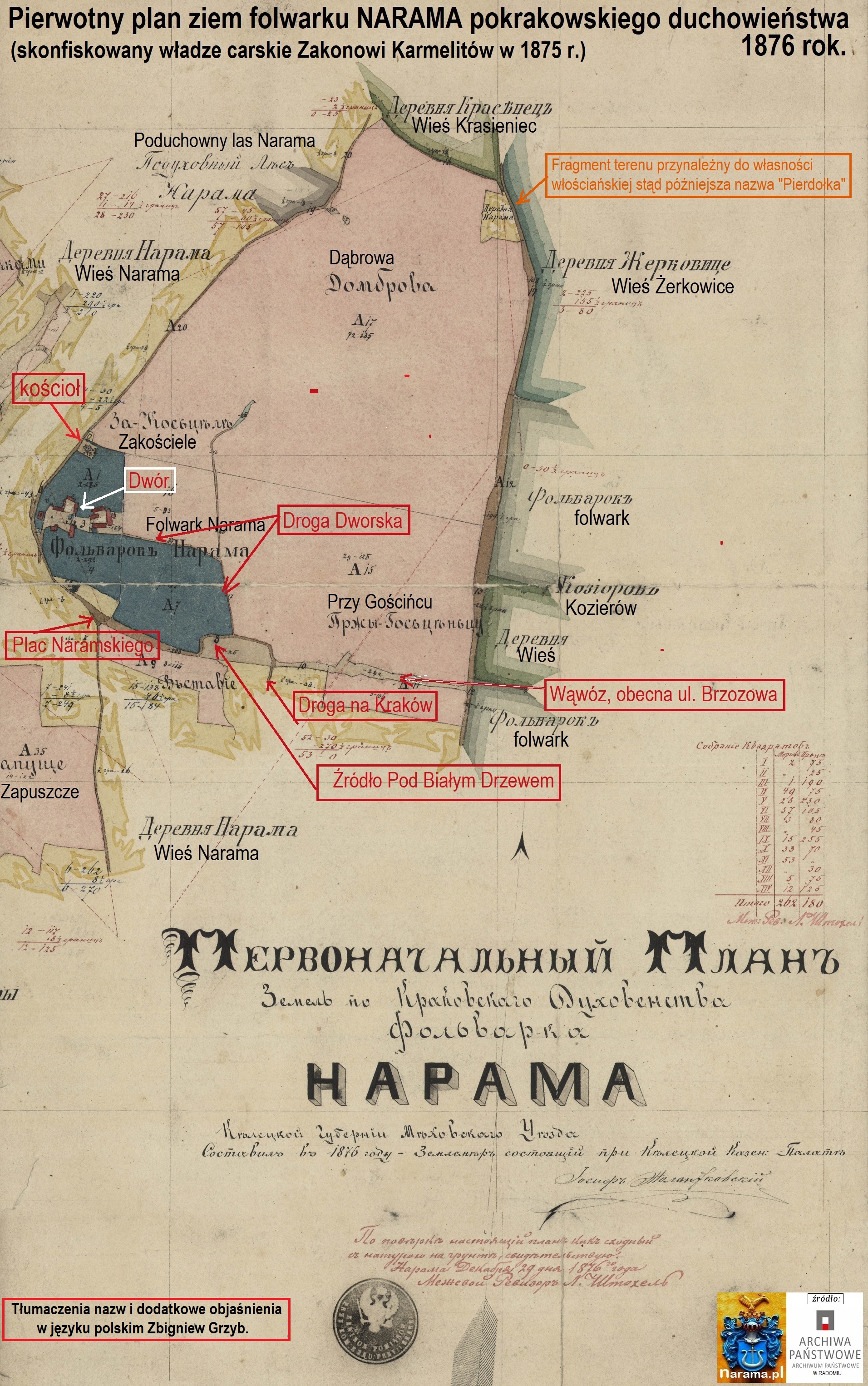
Thus, on March 21, 1781, the auction of the Narama estate took place. It turned out that only one bid was submitted for this “high-profile auction”, and it was not a “high-profile” one but a “written” offer submitted by one Lew Sulnicki. In his bid, he wrote: „Администратора майоратного имения Щепановице Льва Сульницкого Объявление” ("Administrator of the majorat estate Szczepanowice Lew Sulnicki Announcement"). This was the bid of Lew Sulnicki, the administrator of the majorat estate in Szczepanowice, Miechów County. In his offer, he proposed a price of 1,305 silver rubles for the Narama estate, which was 5 silver rubles above the starting price. He attached a receipt for 1,300 rubles as a 10% deposit paid to the Treasury Chamber and a favorable opinion about him issued by the management of the same Chamber, as he had previously worked there.
The Peasants' Land and the Narama Manor
Lew Sulnicki’s offer was accepted. Subsequently, the auction results were approved by all levels of the Tsarist government and the so-called government of the Congress Kingdom. Since there were no other obstacles, detailed agreements and preliminary contracts were signed on May 9 and August 2, 1878, between Lew Sulnicki, as the buyer, and the Kielce Treasury Chamber, representing the Russian Imperial Treasury.
On November 9/21, 1878, before the Kielce notary Konstantin Iwanowicz Golewiński (Cholewiński), Lew Józefowicz Sulnicki and Henryk Osipowicz Chrzanowski of Szczodrkowice, of the Korab coat of arms, completed the act concerning the Narama estate. The day prior, Lew Sulnicki had transferred all ownership rights to the Narama estate to Henryk Chrzanowski. In doing so, Chrzanowski assumed all obligations arising from the purchase agreement between Sulnicki as the buyer and the Kielce Treasury Chamber as the seller. Thus, Henryk Chrzanowski became the owner of Narama. Notably, Henryk Chrzanowski, the last lessee of the Narama estate, was privately Sulnicki’s brother-in-law.
In the early 20th century, Henryk Chrzanowski gave the land and manor in Narama as a dowry to his sister, who married Józef Russocki. Together, they managed the estate. In 1935, Józef Russocki passed away, and his heirs, owning other properties, gradually sold the estate.
After much of the estate was sold, and following the communist takeover, the remaining 14 morgs of the manor were exempt from parceling. The final sale transaction took place in 1947. The manor building was repurposed for the needs of the Narama commune, and after the commune's dissolution, it was sold along with the land plot. Ultimately, the manor building was demolished in 2021.
As for the history of the church, after the Carmelites left the village, the wooden temple practically had no caretaker. In 1869, Russian officials effectively banned the celebration of Mass in Narama. As a result, the church fell into ruin, and items such as the chalice, vestments, and other objects necessary for Mass were moved from Narama to Korzkiew. Occasionally, a priest from Korzkiew, within whose parish Narama lay, would visit the church.
The situation changed after 1905, when, following the weakening of Tsarist power, it became possible to celebrate Mass once a year on the feast of St. Vitus.
Since the chapel was located on the land of the Narama manor, on August 7, 1913, Chrzanowski, as its owner, submitted a request to the Tsarist governor in Kielce for permission to renovate the chapel in Narama. Everything seemed fine except for one fact—Russian authorities were not interested in supporting the Catholic faith in the Tsar-ruled Kingdom of Poland. They demanded a detailed justification for the request, along with a description of the chapel’s history. On August 20, 1913, Chrzanowski provided the history of the chapel, dating back to 1617, highlighting its historical value, likely hoping it would help facilitate the renovation.
At the request of Tsarist officials, on October 30, 1913, Chrzanowski also submitted a professional cost estimate for the renovation, totaling 567 silver rubles and 38 kopeks.
Since the amount of 567 rubles and 38 kopeks was substantial and significantly exceeded the amount indicated in the renovation permit application, after lengthy correspondence, the mayor of the Iwanowice Commune was tasked with gathering the peasants of Narama, Kozierów, and Żerkowice to discuss the matter and ensure they could guarantee the funds for the renovation. A protocol of this meeting was drawn up, signed by all participants.
As a result, the archival documents include a draft of an announcement to be published in the Official Gazette of the Kielce Governorate regarding this matter. However, this was the last record concerning the chapel's renovation, as World War I broke out on July 28, 1914, and in early August 1914, the Russians retreated from Narama, driven out by advancing Austro-Hungarian troops.
With the Tsarist authorities gone, and the church urgently needing renovation, the peasants, under the supervision of the manor staff, repaired the church as their hearts dictated and their skills allowed. Henryk Chrzanowski passed away in 1915.
Following the chapel's renovation, the manor staff and peasants managed to ensure that, starting in the second half of 1914—effectively from the outbreak of World War I—the Korzkiew parish priest celebrated Mass in the Narama chapel at least once a month.
... and after the Great War, the Independent and Sovereign Republic of Poland was born.
Ultimately, thanks to the persistence and determination of Narama’s landowner and peasants, as well as the residents of Żerkowice and Kozierów, who successfully persuaded the inhabitants of neighboring villages (in whole or in part): Damice, Krasieniec, Szczodrkowice, Owczary, and Michałówka, in 1918, Bishop Augustyn Łosiński of Kielce established the Narama parish. It was carved out from the parent parish of Korzkiew and from the parishes of Smardzowice, Minoga, Iwanowice, and Więcławice.
At the time of its establishment, the Main Altar of the Parish Church already housed the image of Our Lady of Mount Carmel. The previous main image, a 17th-century painting of St. Adalbert, was repurposed as a cover for the image of Our Lady of Mount Carmel.
The first administrator and later pastor of the newly established Narama Parish was Father Stefan Marzec. He was 29 years old when he took over the parish.
Between 1918 and 1920, the church was expanded according to the design by Kryński, and a rectory was built. The parishioners, together with the Narama manor owner, provided the parish with 14 morgs of land and constructed farm buildings to ensure the priest's livelihood. In 1928, Father Wacław Ptaszyński became the new pastor of the parish. During his tenure, a parish house for the organist was built, new organs were purchased, and a parish orchestra was formed. It was also during this time that the expanded church, completed in 1922, once again proved too small for the growing number of parishioners. As a result, Father Wacław Ptaszyński began efforts for further expansion, culminating in the addition of a chapel to the church in 1938, designed by Franciszek Mączyński.
Returning to the history of the village.
In 1922, through the efforts of the residents and the then-parish priest, Father Stefan Marzec, two classes of a Public School were established in rented rooms of Władysław Kurtyka's farm building. The headmaster of the school was Tadeusz Piech. After a fire, the school operated in the organist’s house, and later in the home of Ignacy Kluzek and his wife Maria née Wieczorek. Since Narama already had a five-class public school, some children attended the seven-class school in Michałowice for further education. For example, in 1932, 12 children from Narama and Kopanina attended school in Michałowice. The successor of the former school is currently the Public Primary School named after Saint Jadwiga the Queen, with a Preschool Section in Narama.
In 1925, the "Stefczyk" Credit Union was established. In addition to the residents of Narama, the Union also included members from neighboring villages. Father Stefan Marzec served as the Chairman of the Board, and Tadeusz Piech was the Chairman of the Supervisory Board. The Credit Union no longer exists today.
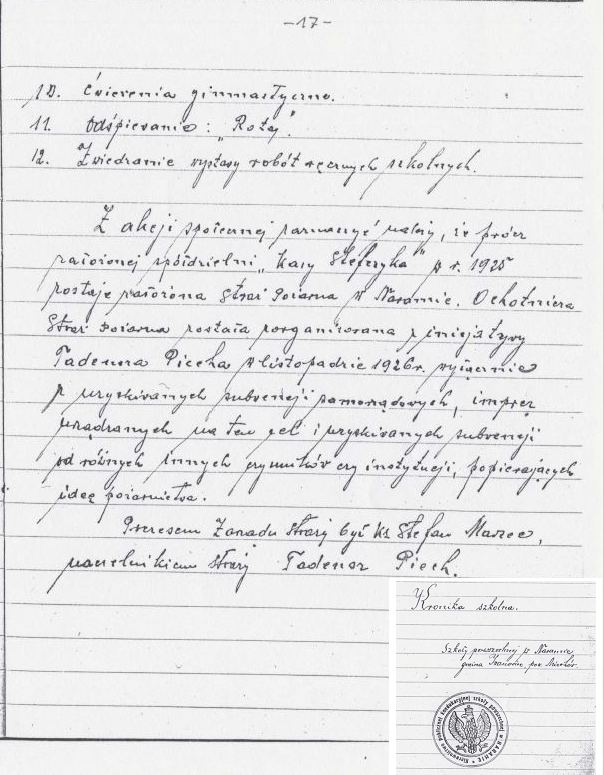
In 1926, through the initiative of Father Stefan Marzec and the school headmaster Tadeusz Piech, the Volunteer Fire Brigade Society in Narama was established. Father Stefan Marzec became the first President, and Tadeusz Piech the first Chief. After the organization of the VFB Society in Narama, Father Marzec and Tadeusz Piech resigned from their roles, and a new board was formed: President Maciej Turek, Chief Wincenty Jurkowski, Secretary Łukasz Krawczyk, Treasurer Paweł Turek, and Quartermaster Antoni Wywiał. The Fire Society was registered on January 9, 1928, under entry number 1496. In 2021, the Volunteer Fire Brigade in Narama joined the National Firefighting and Rescue System.
On March 7, 1926, the Narama Dairy Cooperative was established as a limited liability cooperative. Like the Stefczyk Credit Union, it included residents of villages belonging to the Narama parish. During the interwar period, limited liability cooperatives were economic entities combining features of limited liability companies and cooperatives, where cooperative members were also shareholders.
The cooperative's authorities included familiar figures. This time, Tadeusz Piech became Chairman of the Board, and Father Stefan Marzec was elected Chairman of the Supervisory Board. Other board members were Stanisław Lasek as Vice Chairman and Ignacy Kluzek as Cashier. In addition to Father Stefan Marzec, the Supervisory Board included Leon Banaś as Vice Chairman, Grzegorz Kurowski as Secretary, and Józef Palik, Jacenty Krawczyk, and Mikołaj Machnik as members. Jacenty Ziębiec was appointed as the dairyman and was required to complete courses and obtain the necessary qualifications for the role. The cooperative had no fixed duration.
Archival materials show that the cooperative operated until the outbreak of the war. Following the German occupation, confiscations, and the imposition of quotas, the cooperative ceased to function. On April 1, 1941, the German-controlled State Cooperative Council submitted an application to the Commercial Court in Kielce to remove the cooperative from the commercial register. The cooperative was officially removed from the register on August 31, 1941. After the war, in 1948, the PRL authorities resumed actions regarding the cooperative, rejecting the German decision to dissolve it. Ultimately, in 1949, after determining that the cooperative had no assets, liabilities, or operations, it was permanently removed from the registers.
In 1928, a fire broke out due to the dense and predominantly wooden construction, completely destroying the village. After the fire, a land consolidation process was carried out, which was completed in 1932. Narama became more expansive with scattered buildings, giving significant importance to the names of individual hamlets: Łaziec, Ustki, Podgórz, Odole, Białe Drzewo, Pod Lasem, Za Lasem, Zapuszcze, Pierdółka, Nadlipie.
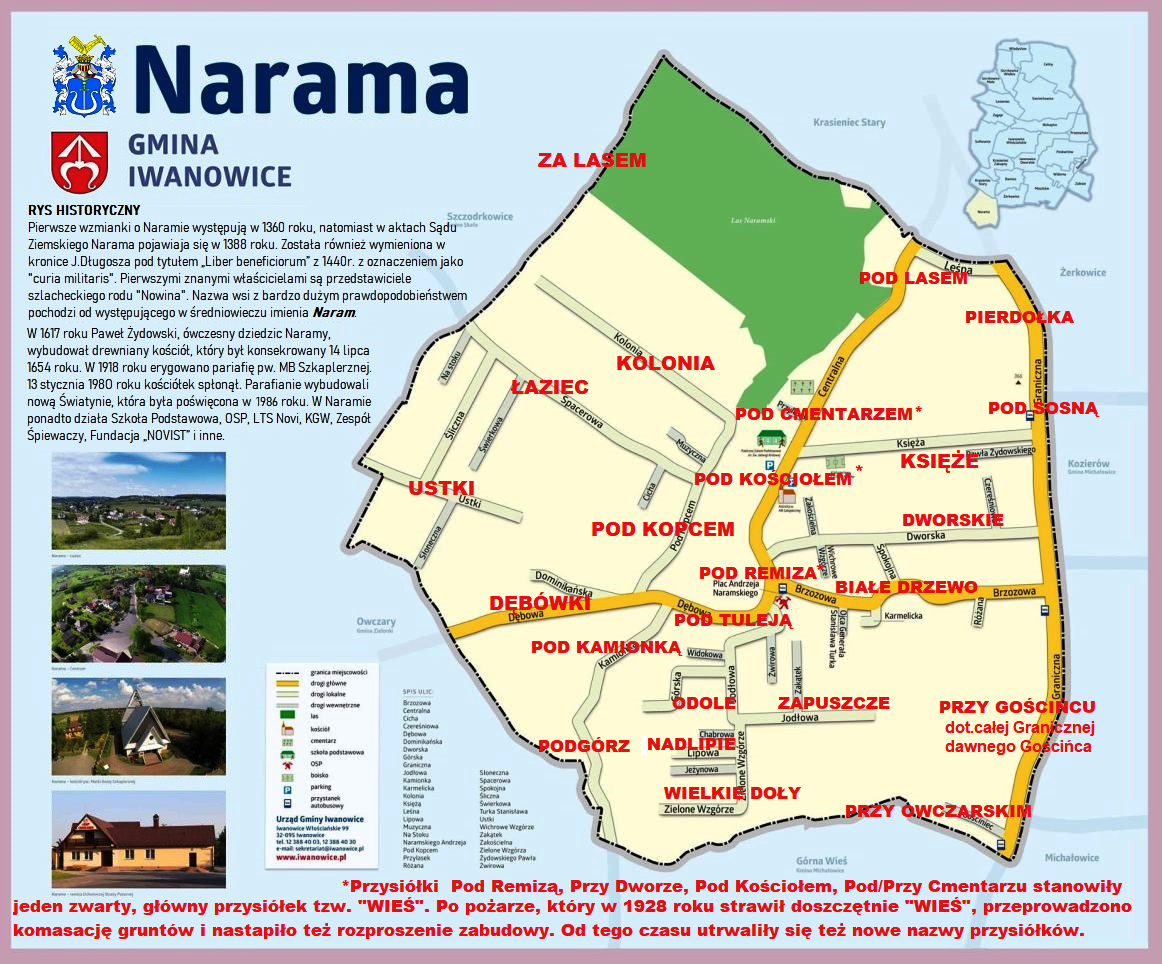
In the photo: A map of the village of Narama, showing the names of rural hamlets (important since the 1928 fire) and the street names introduced in 2015.
Fortunately, the church survived the conflagration. After the fire, Father Wacław Ptaszyński formed a parish brass band. Until 1939, the band was conducted by Władysław Nawrot, followed by Franciszek Czerw in 1946-47, and later his son Julian Czerw from 1956-72. Afterward, Józef Ziębiec took over, and the current conductor is Jerzy Piekara. In the same year, 1932, Father Dr. Jan Piskorz, residing at the rectory, established a group of altar servers.
In 1936, during a village meeting, the idea of building a school was born. The cornerstone was blessed on September 3, 1938, but the building was not fully completed until 1945.
The Difficult Years of World War II.
During World War II, Narama (specifically at the forester's lodge) was a partisan outpost of the AK (Home Army) "Maria" Inspectorate, headquartered in Miechów.
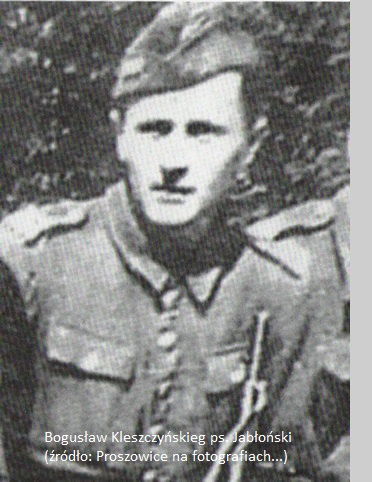
In the photo: Bogusław Kleszczyński, a 20-year-old cadet sergeant of the Polish Underground Army (AK), who died from wounds sustained during a battle between partisans and Germans in December 1944 near Narama. After the war, he was posthumously promoted to the rank of lieutenant in the Polish Army.
In December 1942, shortly after a church service, the Germans carried out a roundup near the church in Narama. They loaded several women onto a truck and transported them to the fire station in Iwanowice, from where they were freed by partisans of the underground Home Army.
In the same year, the Germans confiscated two church bells, one weighing 254 kg and the other 114 kg, leaving only a small hand bell.
From the spring of 1944 until the last Sunday of August, the Home Army unit codenamed "Żelbet," under the command of Lieutenant "Gołąb," stationed in Narama after retreating from a battle with the Germans near the village of Barbarka, received orders to relocate. Before moving to a new area of operations, several hundred partisans marched in formation and fully armed to attend a Holy Mass at the Parish Church in Narama, bidding farewell to the local community and entrusting themselves to God for their journey ahead.
In the winter of 1944, specifically on December 18, a battle between Polish partisans and the German army took place at and near the Narama manor. Lieutenant Bogusław Kleszczyński of the Home Army from Jakubowice near Proszowice was fatally wounded in the battle. Captured wounded soldiers of the Polish underground state were taken by the Germans for interrogation in a Kraków prison.
From Post-War Years to the Present.
Between 1954 and 1961, the Narama Commune existed. It included the villages of Narama, Krasieniec, Damice, and Żerkowice from the dissolved Iwanowice municipality, as well as Kozierów from the dissolved Michałowice municipality (these villages were part of the Narama Parish). The council members were residents from these villages (to be completed with notes), and the Chairman of the GRN Presidium was Stanisław Brożek. The commune was dissolved on December 31, 1961, and incorporated into the Iwanowice Commune.
In 1967, the electrification of the village was completed, with significant contributions from residents in the form of community work.
In 1969, the Women’s Rural Circle (Koło Gospodyń Wiejskich) was established in Narama, and it has been active ever since. Since 1985, the "Naramianki" Folklore Ensemble has also been active.
In the mid-1970s, the interior of the church in Narama underwent a thorough restoration. Notably, the church housed a painting of St. Paul from 1460 by the Kraków monk Jan of Nysa. Originally, this work was a panel of a triptych altar. It is unknown how it ended up in Narama or what happened to it. In the months leading up to the fire, the painting hung in the sacristy. Although some sacristy items were saved during the fire, the painting was not among the items recorded as recovered.
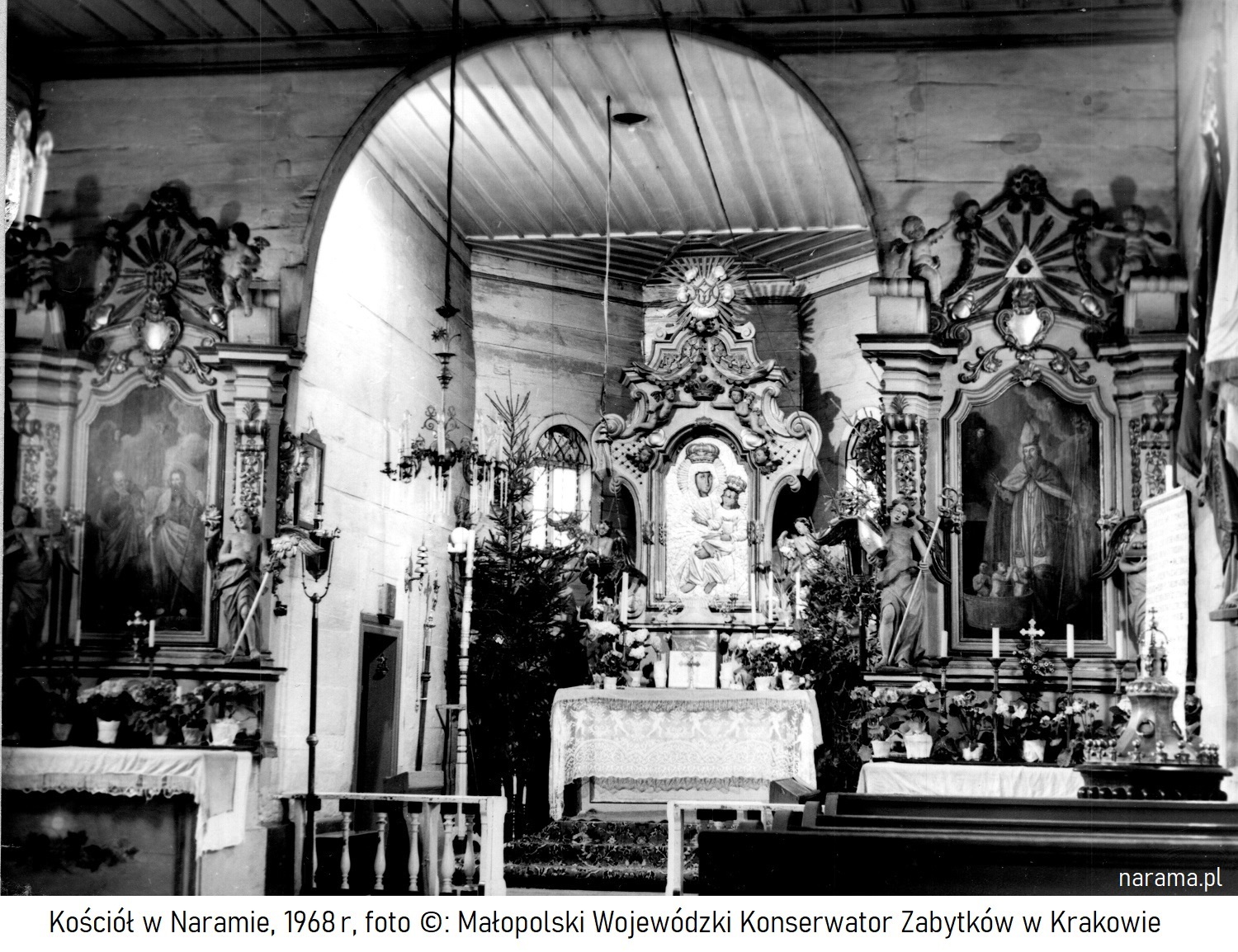 In the photo: Nave with the main altar of the church in Narama. This is part of the church, which was built in 1617. Photo from 1968, before the renovation of the polychrome inside the church in 1974.
In the photo: Nave with the main altar of the church in Narama. This is part of the church, which was built in 1617. Photo from 1968, before the renovation of the polychrome inside the church in 1974.
The Narama Church was one of the gems of the Wooden Architecture Trail in Poland. Unfortunately, on January 13, 1980, it burned down completely along with all its historic furnishings. Fortunately, despite this tragedy, the parish priest, Father Zdzisław Ligorowski, who had arrived in Narama in 1974, had already constructed a new rectory prior to the fire. The old rectory was temporarily converted into a chapel where services could be held. A year later, the construction of a new brick church began.
It is worth noting that during the construction work, the actual grave of Paweł Żydowski was confirmed to exist near the altar.
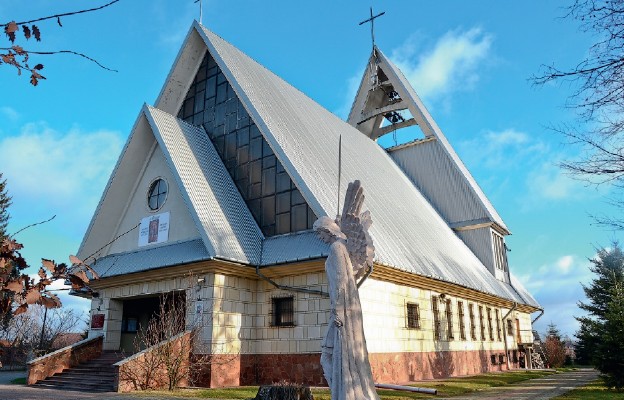
In the photo: The new church built between 1980 and 1986. On November 9, 1986, it was consecrated by Bishop Stanisław Szymecki of Kielce. Next to the church stands a statue of St. Michael the Archangel, erected in 2017.
The new church features marble side altars, a 20-stop pipe organ, a statue of Our Lady of Mount Carmel, the church's patron, and stained glass windows. The exterior of the church building is clad in Pińczów stone. On November 9, 1986, Bishop Stanisław Szymecki consecrated the new parish church. In 2017, the Narama Parish celebrated the 400th anniversary of the church in Narama. In 2018, a statue of St. Michael the Archangel, crafted and donated to the parish by Professor Marek Dryniak, was placed in front of the church and blessed by Bishop Andrzej Kaleta on September 29, 2018.
Between 1980 and 1990, a water supply system and gas network were installed in Narama, most roads were built and paved, and the fire station was expanded. Most of these works were completed as part of community efforts by the residents. Additionally, a municipal bus route, MPK line 257, was opened, connecting Kraków-Kleparz with Narama.
In 1997, the expansion of the school building began, which was completed in 2006. In 2000, the school was named after Saint Queen Jadwiga.
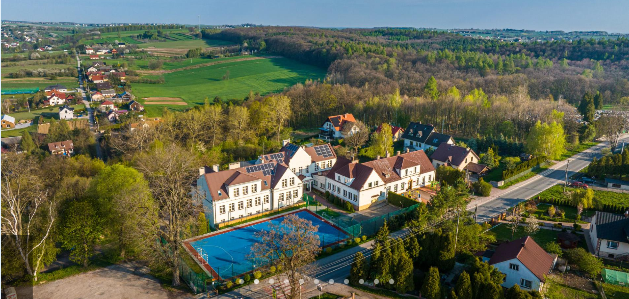
In February 2005, the Iwanowice Commune Council passed a resolution to close the school in Narama as of August 31, 2005. On September 1, 2005, Mr. Krzysztof Zadora established a private school with a public character, which continues to operate to this day. Between 2013 and 2014, a gymnasium was built and opened, financed by the commune with significant support from European funds.
Since 2011, further expansion and modernization of the Volunteer Fire Brigade (OSP) station has taken place. In 2014, the commune purchased a plot of land in the village center next to the fire station and transferred its management to OSP Narama.
At the beginning of the first decade of the 21st century, during the tenure of Father Józef Tkacz as parish priest of Narama, football enthusiasts proposed the idea of building a full-size sports field. They approached Father Tkacz with their idea, and after consideration, he allocated a plot from the so-called parish fields for the field's construction. Work began, and his successor, Dean Jan Jurkowski, upheld the decision to provide the land for the sports field. The field was built with contributions, equipment donations from local entrepreneurs, and community labor by football enthusiasts and residents.
In 2012, the Folk Sports Association "Novi" Narama was registered, with members hailing from the villages that make up the Narama Parish. To support the newly established sports club, in 2014, the commune authorities decided to reduce the size of the pumping station building to the necessary minimum and allocate the remaining space for the needs of LTS "Novi" Narama.
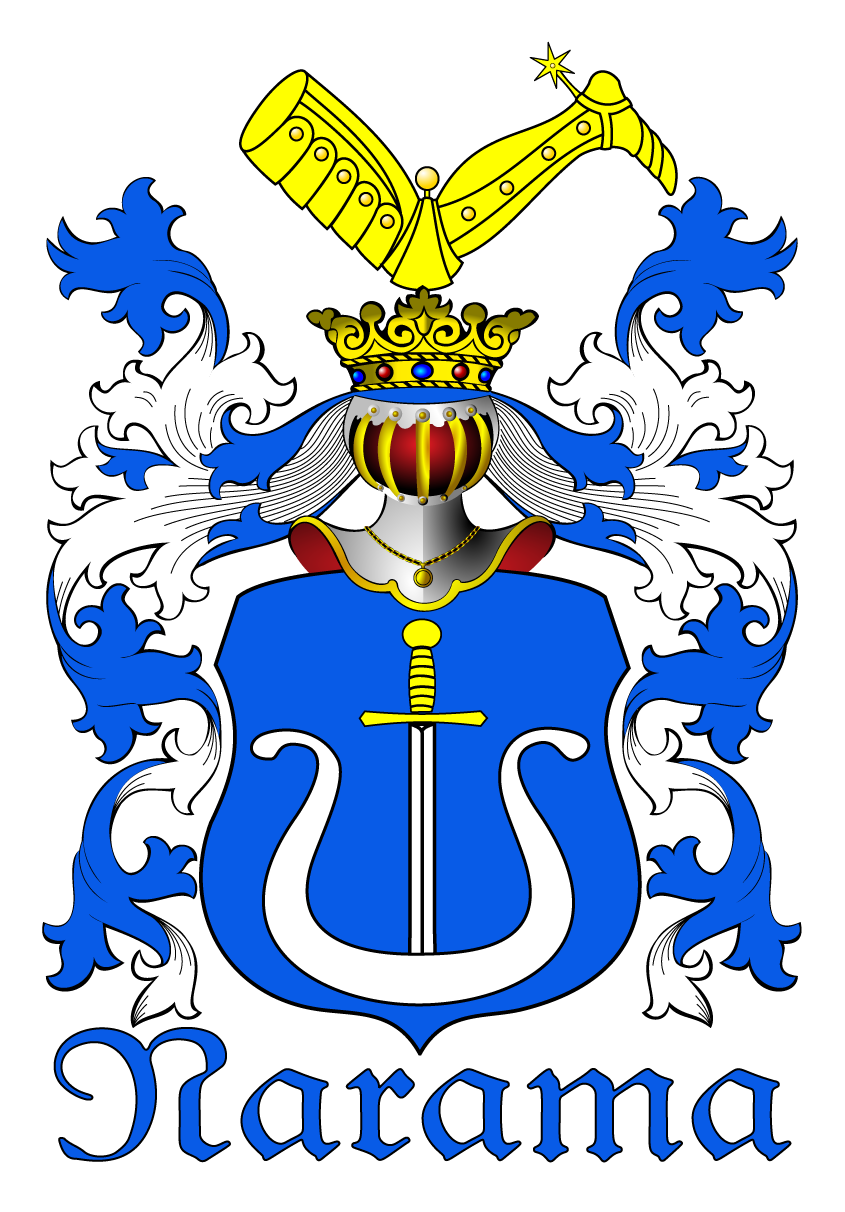
On March 6, 2013, the Iwanowice Commune Council, by Resolution No. XXXI/212/2013, approved the request of the residents made during a general village assembly and adopted a resolution to grant the village the coat of arms "Nowina," the noble emblem of its probable founders. On October 26, 2016, the Iwanowice Commune Council passed a resolution introducing street names for the roads in Narama.
In 2018, the "NOVIST" Foundation was registered, actively supporting the local community.
In 2021, through the combined financial efforts of the Iwanowice Commune, the provincial government, state administration, the State Fire Service (PSP), own funds, and donations, a new medium fire truck was purchased for the volunteer firefighters of Narama. In December of the same year, OSP Narama joined the nationwide rescue network, the National Firefighting and Rescue System (KSRG). This means that, although it is formally a voluntary and non-professional fire service, it is so well-trained and equipped that it can perform rescue operations at the level of a professional fire service and cooperate with state fire units.
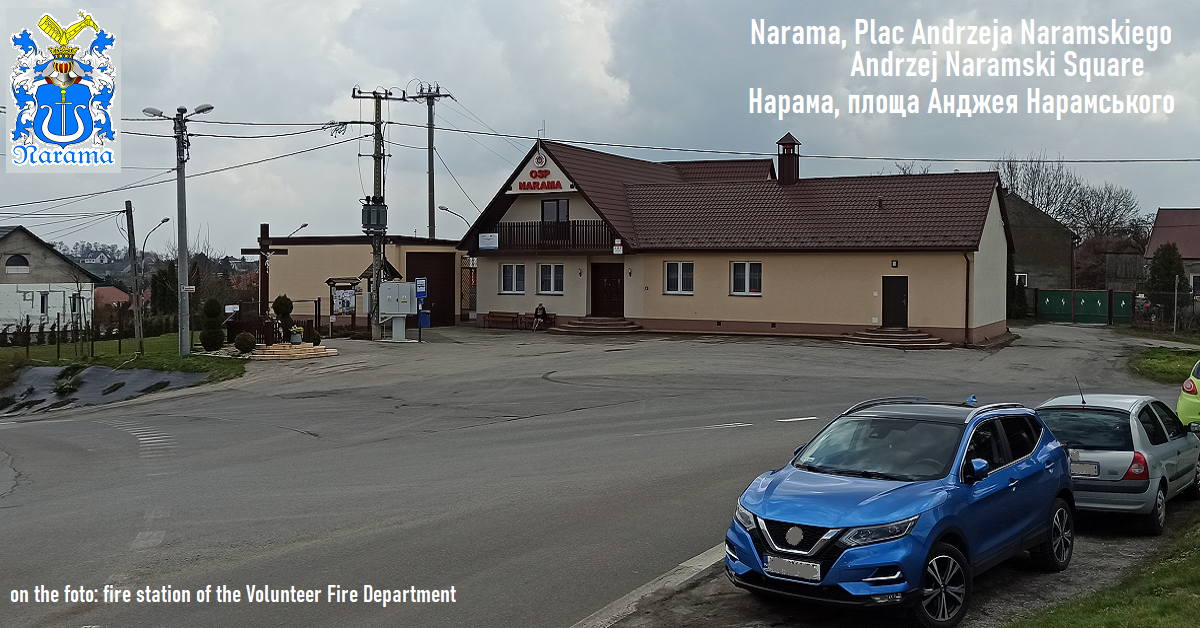
Currently operating in Narama:
- Parish of Our Lady of Mount Carmel in Narama,
- Public Primary School named after Saint Queen Jadwiga, with a Preschool Section in Narama,
- Volunteer Fire Brigade-KSRG Narama,
- Folk Sports Association "Novi" Narama, with men's, women's, and youth sections,
- Brass Band "Naramianka,"
- Women's Rural Circle,
- Folk Singing Group "Naramianki,"
- "Novist" Foundation,
- and others.
Discover Narama: Interesting Facts and Highlights

Tulej
In Narama, there is a pond and a hamlet called "Tulej." The origin of this name is unclear. While it seems to have a specific meaning, especially since there are many people in Poland with the surname Tulej, its exact etymology remains unknown. It might derive from the word "tuł," which historically referred to a quiver for arrows, but this requires further research. Historical records from 1715 mention a resident with a similar surname, written as Tuleÿnÿ—Stanisław Tuleÿnÿ. In Narama, the name "Tulej" was given to a large pond fed by four substantial springs, located halfway down a steep descent on the road to Owczary. Elderly residents recalled that the pond was so deep it could "fit four men standing on top of each other." This pond was used for watering and bathing horses, providing water for livestock, washing clothes, and even as a swimming spot for local youth. It is said that the springs feeding the pond were so abundant that the water was continuously refreshed, keeping it exceptionally clean. Excess water flowed into a roadside ditch and continued towards Zielonki. I still remember the days when my friends and I would go to Tulej after school on summer afternoons to swim. Today, the pond is silted up and overgrown.
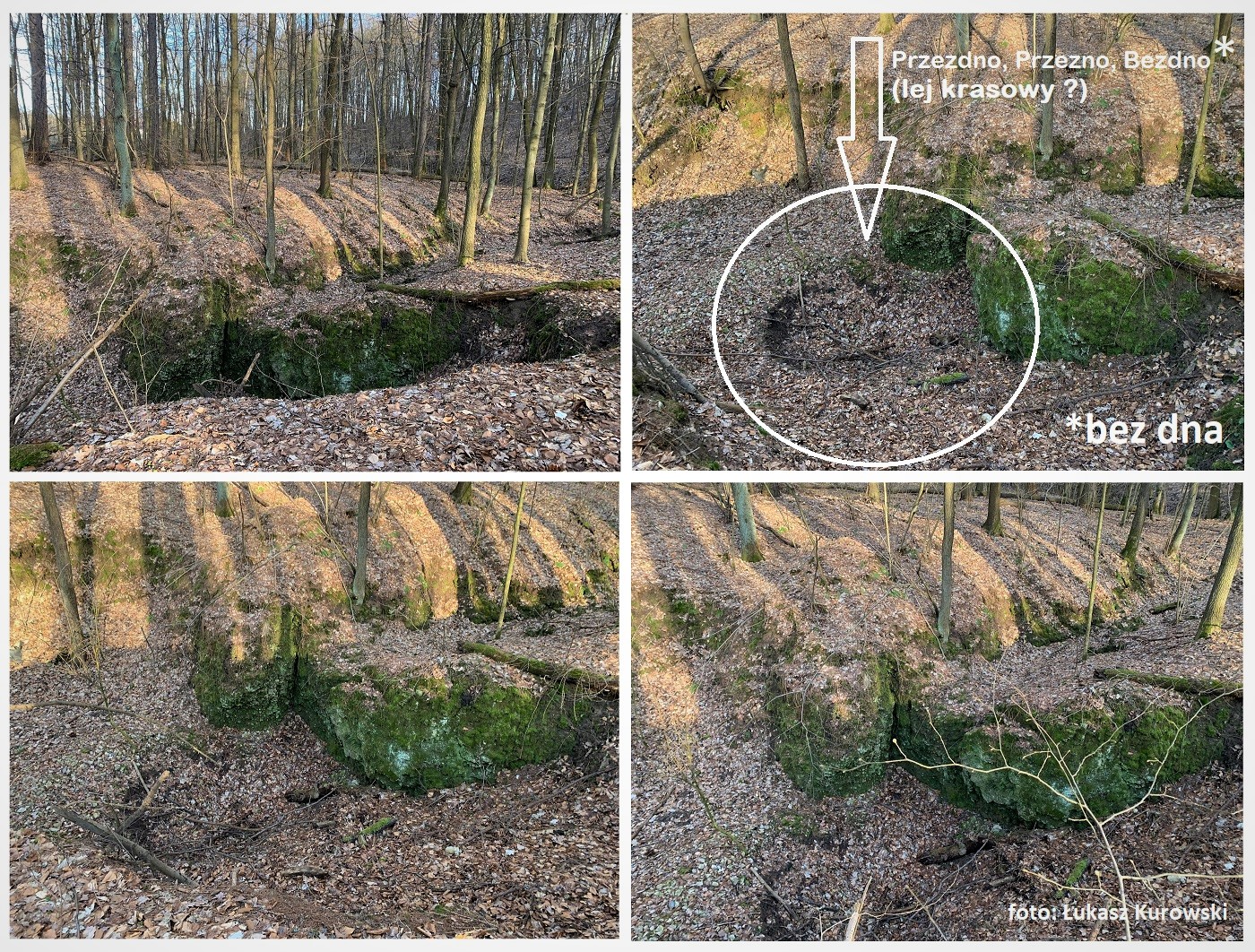
PRZEZNO (PRZEZDNO, BEZDNO)
In the forest, along the road leading from today’s Narama hamlet "Za Lasem" to the hamlet "Kolbuszowa" in Szczodrkowice, lies "Przezno." What exactly is Przezno? According to local lore, it was a small pond with one spot so deep that no one could find its bottom, hence the name "bottomless pond." The place is shrouded in numerous legends and chilling tales. One legend tells of a landowner who, along with four horses and a carriage carrying his guests, drowned in Przezno. They vanished so thoroughly that neither the bodies of the drowned nor the horses or carriage were ever recovered. People avoided the area at night, as screams of the drowned were often heard, and those who approached the pond in an attempt to help were said to be pulled in themselves.
Most likely, it is a deep limestone karst sinkhole, which are relatively common on the Kraków-Częstochowa Upland. Water continuously flowed from Przezno, although today the pond is silted and overgrown. Fallen branches have intertwined to form a kind of pseudo-bottom, making the water no longer visible. However, the area remains very dangerous, and people are strongly warned against stepping onto the visible depression, as it poses a significant hazard.

The Spring Under the White Tree
Along the road from the fire station towards Kozierów, in the hamlet "Białe Drzewo" (White Tree), begins a valley that stretches all the way to Kraków. In this valley, there was a centuries-old, stone-lined well from which water continuously overflowed. The well served the locals, especially during drier years, as a vital source of water. It is said that there was always a line at the well, yet it never ran dry, thanks to its strong springs.
According to legends, people feared walking near the well at night, as a "white lady in a veil" would appear, softly wailing. The sound of horses' hooves could be heard, and ghostly "silhouettes of horses" were seen. Stories also tell of a treasure buried in this ravine long ago. No one has ever found it and likely never will, as the ravine has since been filled in. Despite this, the powerful springs continue to force water out from beneath the layers of debris and soil. Unfortunately, the water is no longer as clean as it once was.
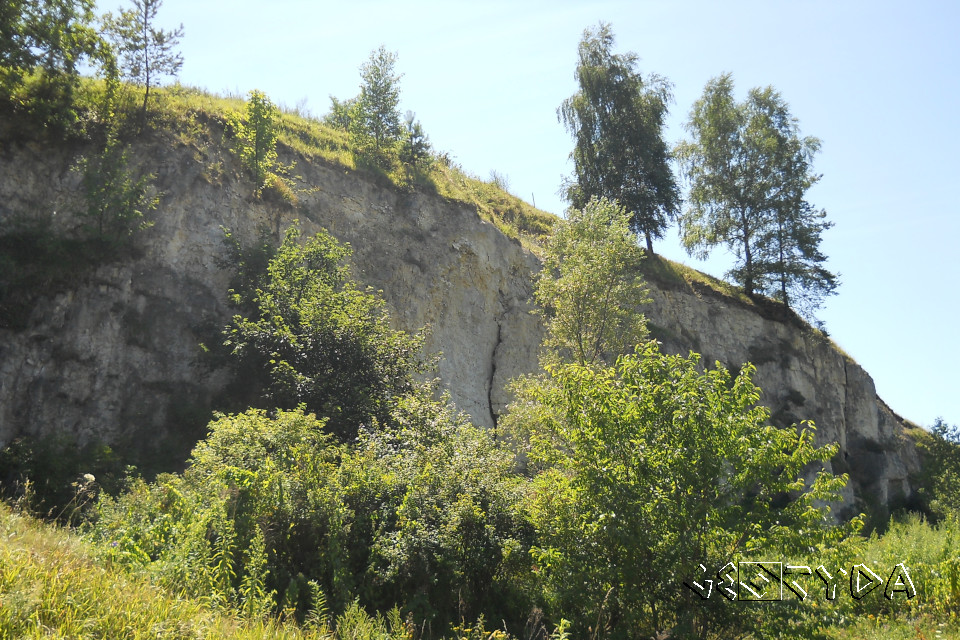
NARAMKA
Narama is also the source of the well-known "Naramka Valley" and the "Naramka" river, popular among hikers. Both the Naramka Valley and the Naramka river extend through Międzygaje, Garlica, and Zielonki, eventually reaching Kraków. The sources of the Naramka stream once included Przezno, Tulej, the Well at the White Tree, the periodically appearing spring in Ustki, and other temporary springs in Kopanina and Łaziec. Sadly, none of these sources exist anymore. What a loss!
The Naramka Valley, also called the Garliczka or Owczarska Valley, stretches about 9 km from Narama in the Iwanowice commune to Zielonki, where it merges with the Prądnik Valley. For the most part, the valley is shaped by Cretaceous deposits, visible as whitish marl crumbling from the slopes. Upper Jurassic rocks are rare and not prominently exposed, appearing mainly near Międzygaje on the steep, forested orographic left slope and near the river's mouth. The Naramka Valley has been significantly altered by human activity but still retains some scenic value, particularly in the section from Narama to Międzygaje (Owczary), with lesser preservation further downstream towards the outskirts of Garliczka (source: "From Kraków to Ojców").
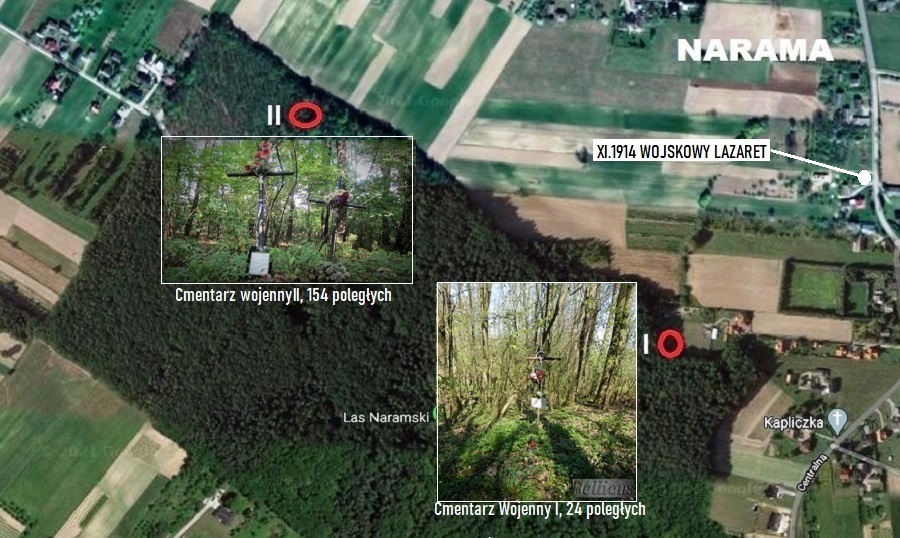
CEMETERIES IN THE NARAMA FOREST
During World War I, fierce battles were fought around Narama between the Austro-Hungarian armies and the armies of the Russian Empire. Many soldiers lost their lives in these clashes. Military field hospitals (lazarets) were also established in Narama, Damice, and Krasieniec, where numerous soldiers succumbed to their wounds. As a result, Narama and its surroundings are home to several cemeteries with mass graves of soldiers.
In Narama, the first cemetery is located about 1.2 km north of the village center, on the edge of the Narama forest. A mass grave holds 24 Austro-Hungarian soldiers and one Russian soldier. This cemetery is marked. The second cemetery is about 1.5 km north of the village center, in the northwestern part of the Narama forest. A mass grave there contains the remains of 154 Austro-Hungarian soldiers, and this cemetery is also marked.
Another military cemetery from this period is documented in Austrian records. It was located near a ravine, approximately 128 paces from the village of Kozierów towards Narama. Unfortunately, after the 1928 fire and subsequent land consolidation in Narama, the layout of roads changed, making it difficult to determine the exact location of this grave. Evidence suggests that it may be near the current Brzozowa Street, 128 paces (an Austrian military measure from the World War I era) from Graniczna Street. At that time, a cross stood at the beginning of the ravine in this area.

THE SECRETS OF THE NARAMA FOREST!
For those who wish to delve deeper into the history of Narama, the "Secrets of the Narama Forest" Educational Trail offers a unique opportunity. This marked trail takes visitors through the Narama forest, showcasing its natural beauty while also revealing its mysteries. Within this forest are mass graves from World War I. The trail is marked with a special graphic symbol, and along its path, informational boards have been installed.
There are boards at the forest entrances—one from Narama, one from Szczodrkowice—and two along the trail: one about the war cemeteries from World War I and another about the history of the Home Army in Narama. Additional boards are placed at each mass grave, describing their history. All boards are double-sided, with one side featuring nature-related information prepared by the Miechów Forest District, and the other side covering historical topics, authored by Dr. Przemysław Wywiał, professor at UKEN. The trail also has its own QR code linking to a dedicated website.

A MIRACLE OF BIRTH
In December 1942, the Germans conducted a roundup near the church in Narama. They loaded several women onto a truck and transported them to the fire station in Iwanowice, from where they were liberated by members of the Home Army (AK). Among the detainees was a woman in advanced pregnancy. Following her release, labor began. A successful delivery took place in one of the local farmhouses. This is how Mr. Marian Dziwisz, originating from Michałówka, Narama Parish, came into the world—a story he often recounts himself.
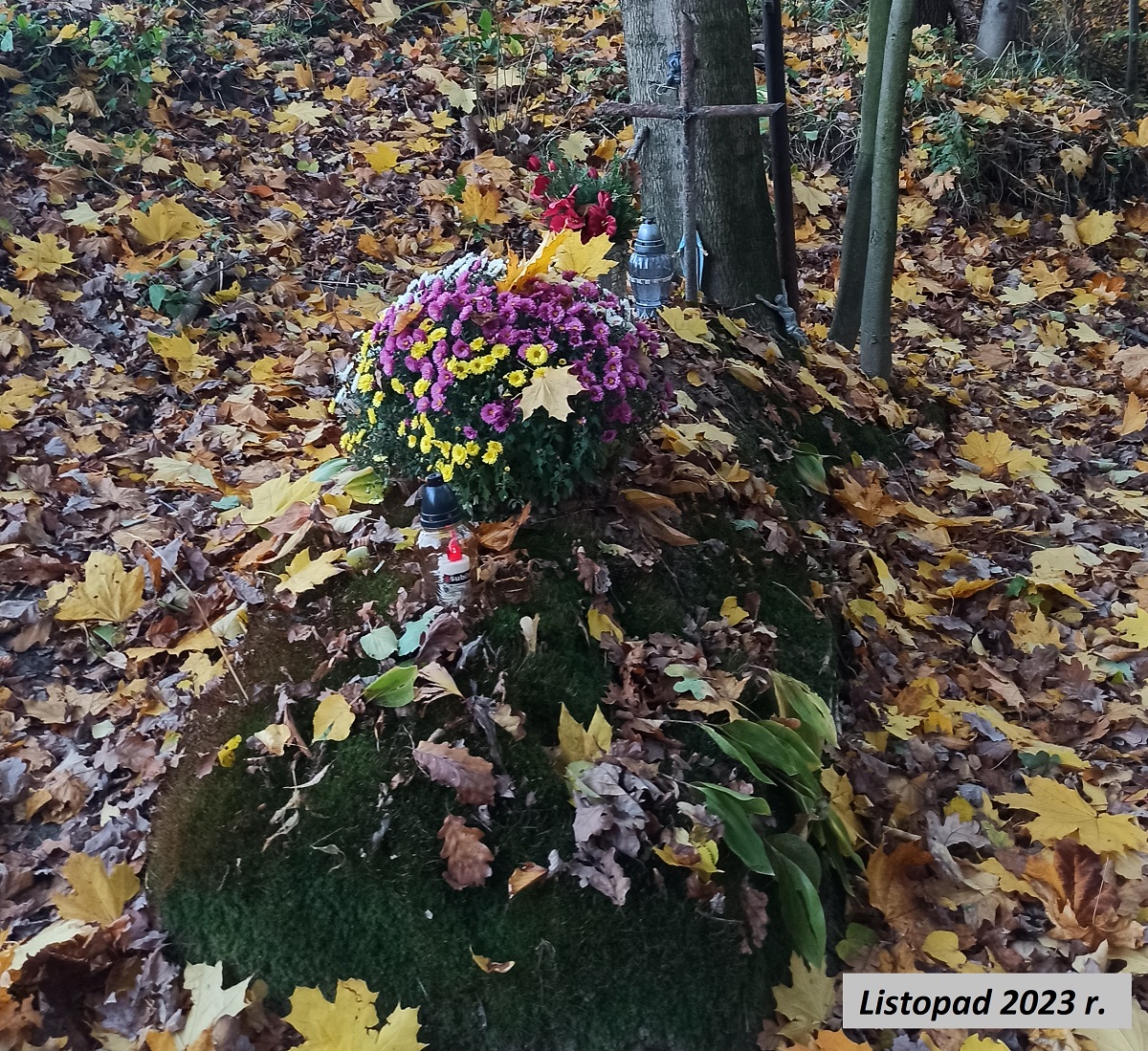
VICTIMS OF "ZYGMUNT"
In 1941, a 20-year-old Silesian German Nazi named Zygmunt brutally tormented the residents of Narama. He frequently roamed between houses, watching and observing whether anyone was doing anything forbidden by the Germans. If he caught someone, he would beat them with a whip until they lost consciousness. Among his atrocities, he tracked down and personally murdered, in front of German gendarmes, a Jewish family of four. They were buried on the outskirts of the Catholic cemetery.
When the situation became unbearable for the residents, the Polish Underground State issued a death sentence for Zygmunt. To carry it out, Polish partisans ambushed Zygmunt away from the village and executed him. Along with Zygmunt, a German gendarme nicknamed "Dziekan," who also tormented Poles, was killed.
There were reports after the war, in 1946, that the family was moved to a Jewish cemetery. However, according to most familiar with the subject, the family remains in their original burial place. Additionally, oral tradition suggests that this site may have already contained a grave from the uprisings during the partition period. Thus, it is possible that five individuals, not four, rest in this spot. May they rest in peace.
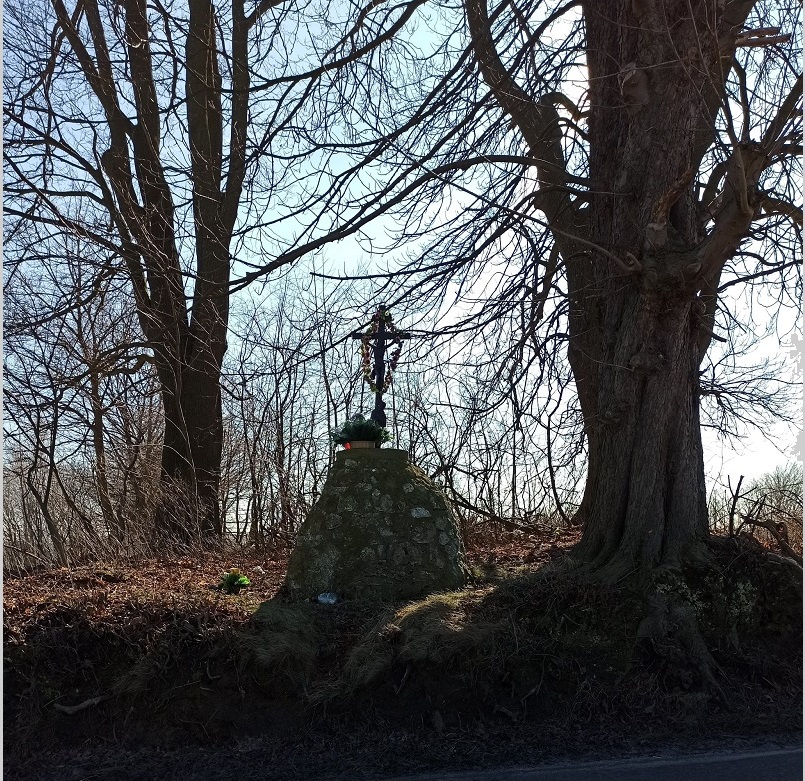
THE CHOLERA CEMETERY
On the border between Narama and Owczary lies the so-called Cholera Cemetery. The first burials there likely date back to the cholera pandemic of 1831. It remains unclear whether this burial site is solely associated with victims of that period or also with earlier or later outbreaks. Interestingly, on maps from the late 18th century, this location is not yet marked with a cross.
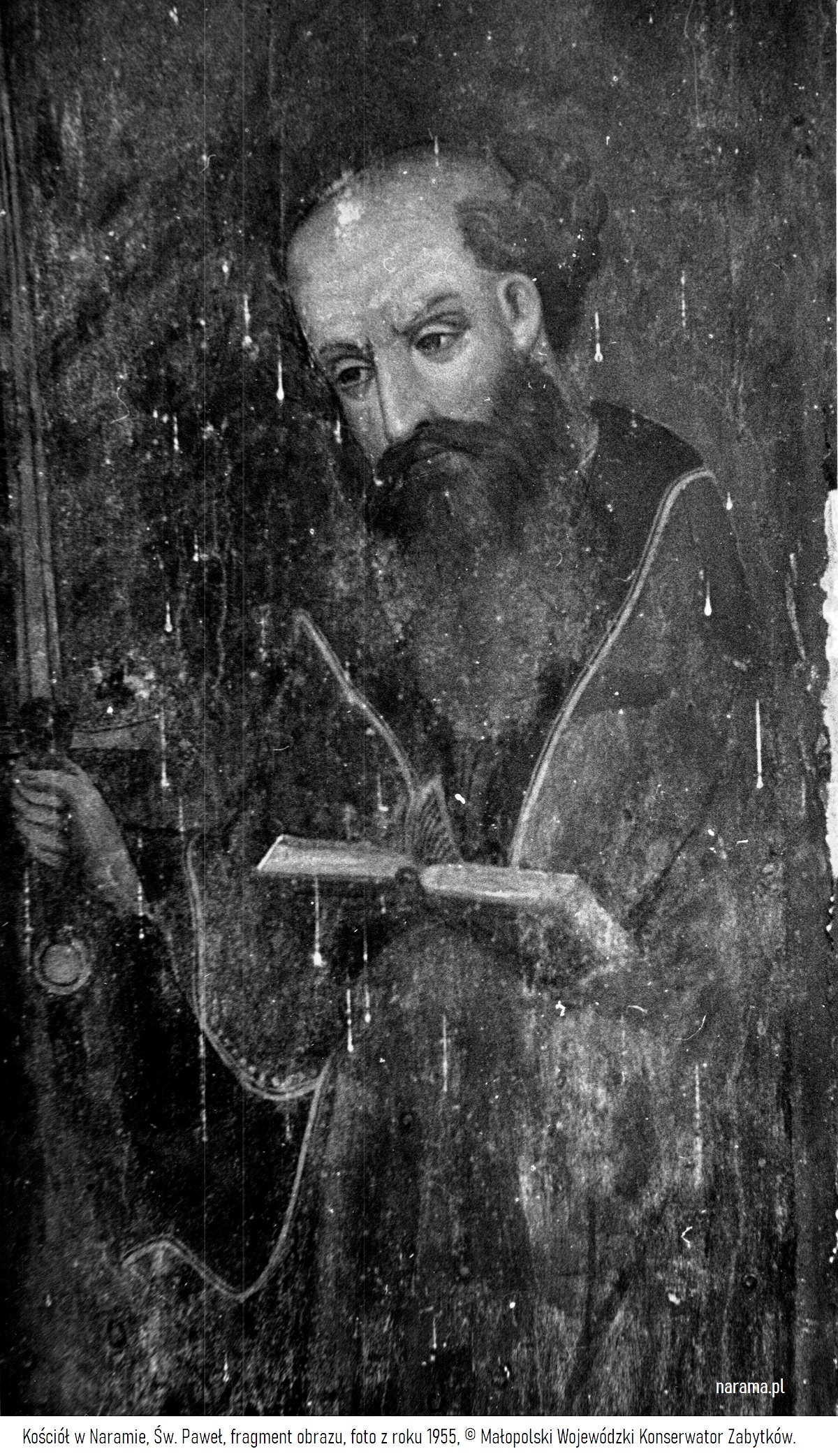
A MEDIEVAL MASTERPIECE IN THE CHURCH OF NARAMA
The church once housed a painting of St. Paul from 1460, created by the Kraków monk Jan of Nysa. It hung in the church sacristy. Originally, this work was a wing of a triptych altar. It remains unclear how the painting came to be in Narama or what ultimately happened to it. It is most likely that the artwork was destroyed in the fire that consumed the church, although this is not certain. Some of the sacristy’s furnishings were saved, but the painting was not among the rescued items.
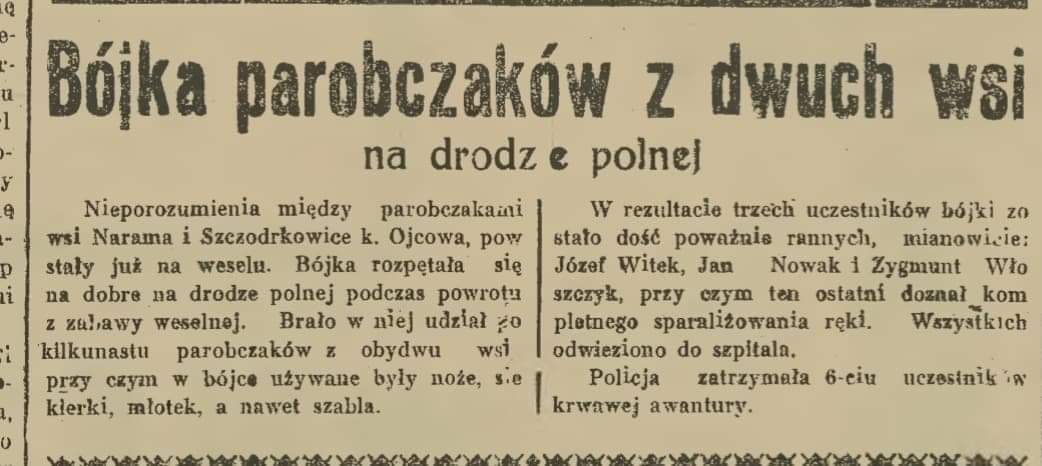
NEIGHBORLY DISPUTES
As reported by *Ekspres Zagłębia* (Issue No. 152, 1939), a brawl broke out on the country road between Narama and Szczodrkowice involving farmhands from both villages. The fight included several dozen hot-tempered men. During the altercation, knives, hatchets, a hammer, and even a saber were used. As a result of these neighborly quarrels, three participants were seriously injured, one of whom was left permanently disabled.
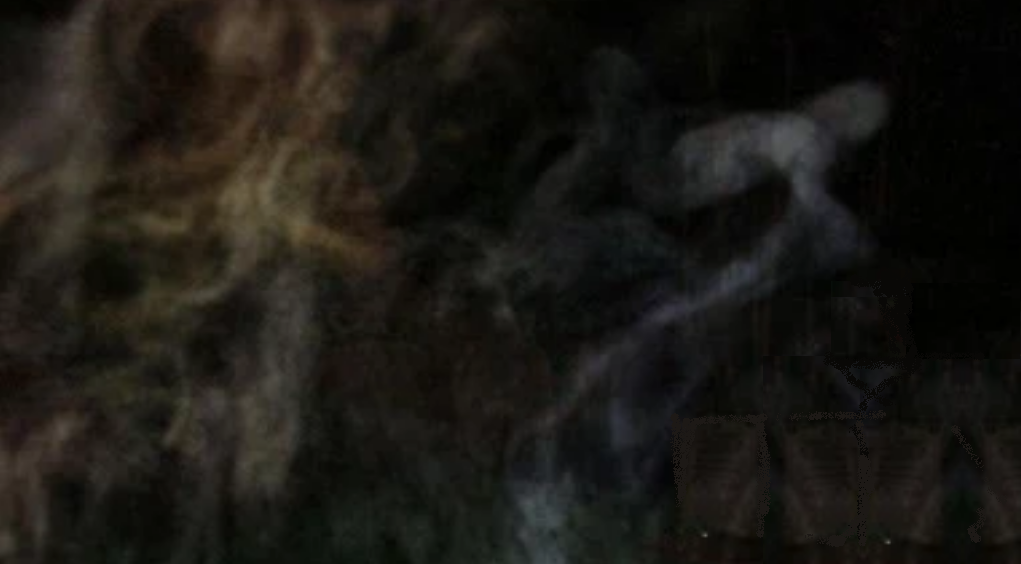
PHANTOMS OF NARAMA
In Narama, as in other places, supernatural occurrences have been reported. Stories tell of a girl in a wedding dress with a veil over her head appearing in the Narama cemetery. She is said to be the spirit of a parishioner whose fiancé tragically died on their wedding day. Someone reportedly spoke with her, claiming that she is waiting for her wedding ceremony to be performed over her beloved’s grave. Meanwhile, near the well in the valley under "Białe Drzewo" (White Tree), a young woman could be encountered at night, wandering with moans as she searched for her lost child.
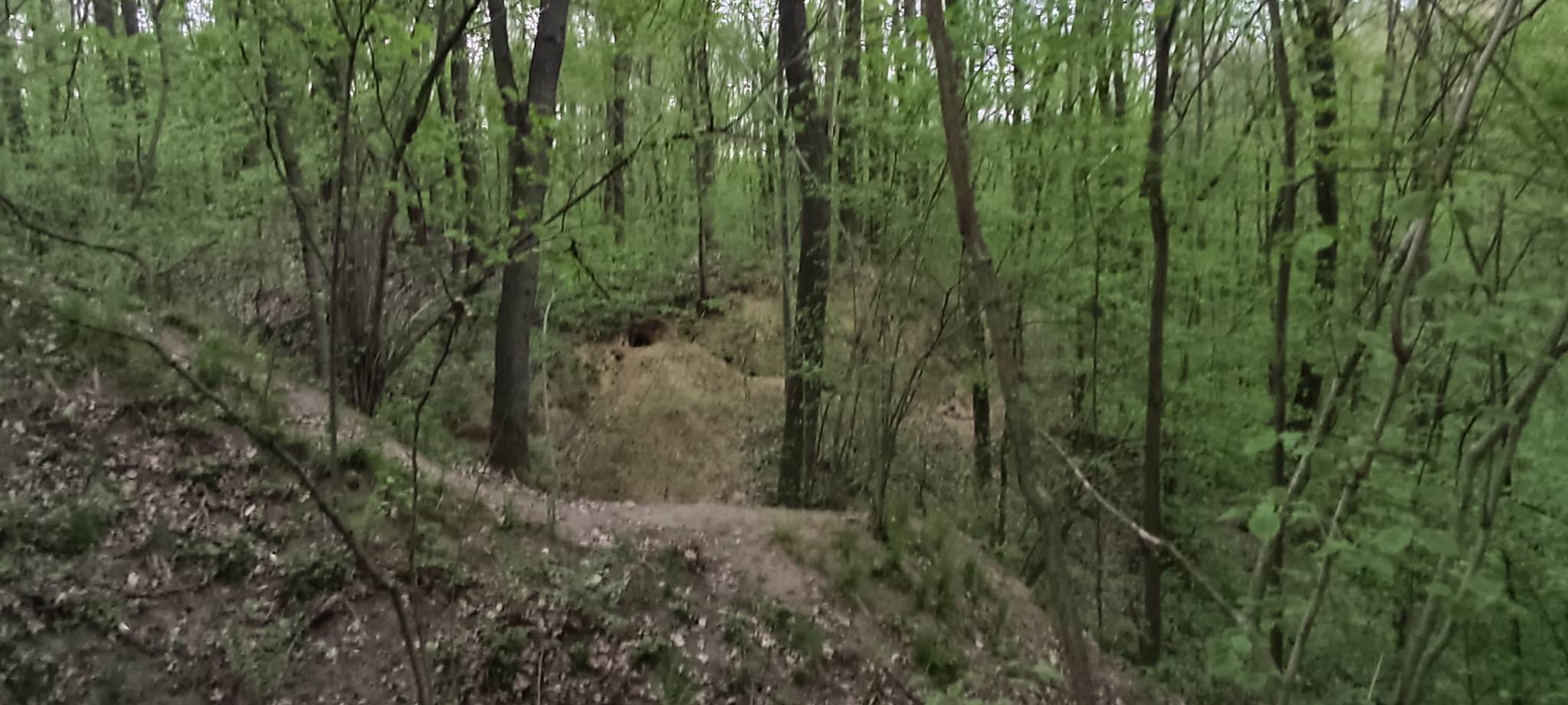
THE MYSTERIOUS FOREST OF NARAMA
The Narama forest is characterized by remarkable biodiversity, especially in the Naramka Valley, stretching from the Narama cemetery to the dry riverbed of the Naramka. Here, you can find anemones and marsh marigolds. The forest is also home to badger colonies, evidenced by their large setts. The Narama forest holds a special place in the collective memory of its residents. From time immemorial, it provided wood for building homes and fuel, as well as forest undergrowth and litter used in both manor and peasant farms. After Poland regained independence, and well into modern times, the forest became a gathering place for youths from nearby villages, where the sounds of harmonicas and violins often filled the forest clearings. Remarkably, the forest was considered a neutral zone, where any inter-village feuds or disputes were forbidden—a rule that was strictly respected. The forest was also a frequent destination for school trips, scouting meetings, and outdoor games and activities for young people. In recent times, however, various regulations and restrictions have been introduced, effectively isolating the forest from the local community.
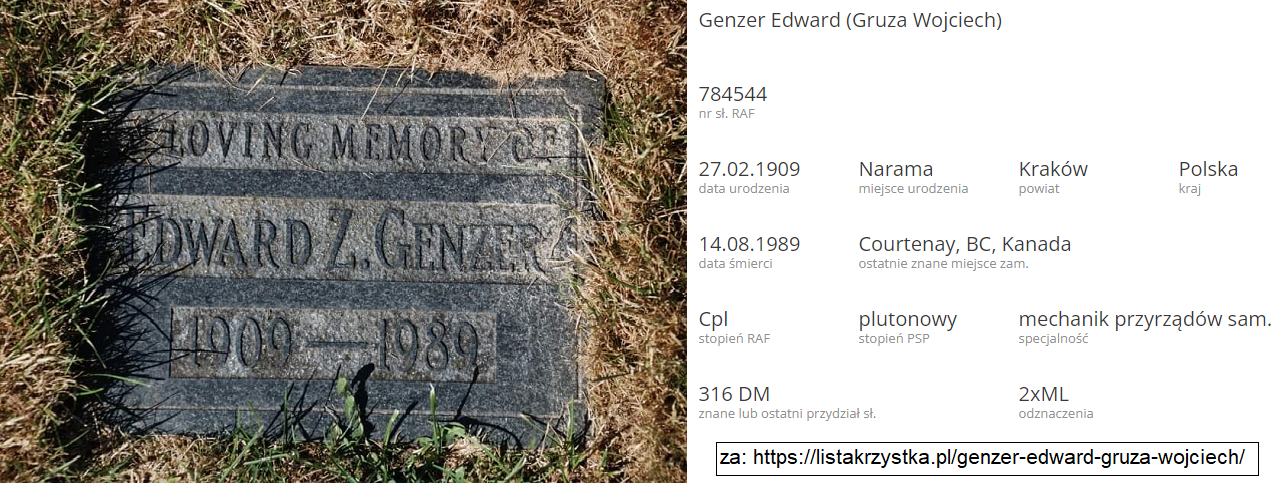
SERVING IN THE POLISH ARMED FORCES IN THE WEST...
Among the personnel of the Polish Air Force in Great Britain was a soldier who, according to archival documents, was born in Narama. His name was Edward Genzer, born as Wojciech Gruza on February 27, 1909, in Narama, and passed away on August 14, 1989, in Courtenay, British Columbia, Canada. He held the rank of Corporal in the Polish Army and worked as an Instrument Repairer (aircraft instrument mechanic). "Gruza" might be a distorted version of the surname "Gruca," which was known to exist in Narama at the time. Another notable resident of Narama was Władysław Bubak from Ustki, a soldier of Anders' Army, participant in the Battle of Monte Cassino, and a member of the Military Orchestra, which was likely the first to perform the famous song "Czerwone Maki" (*The Red Poppies*).
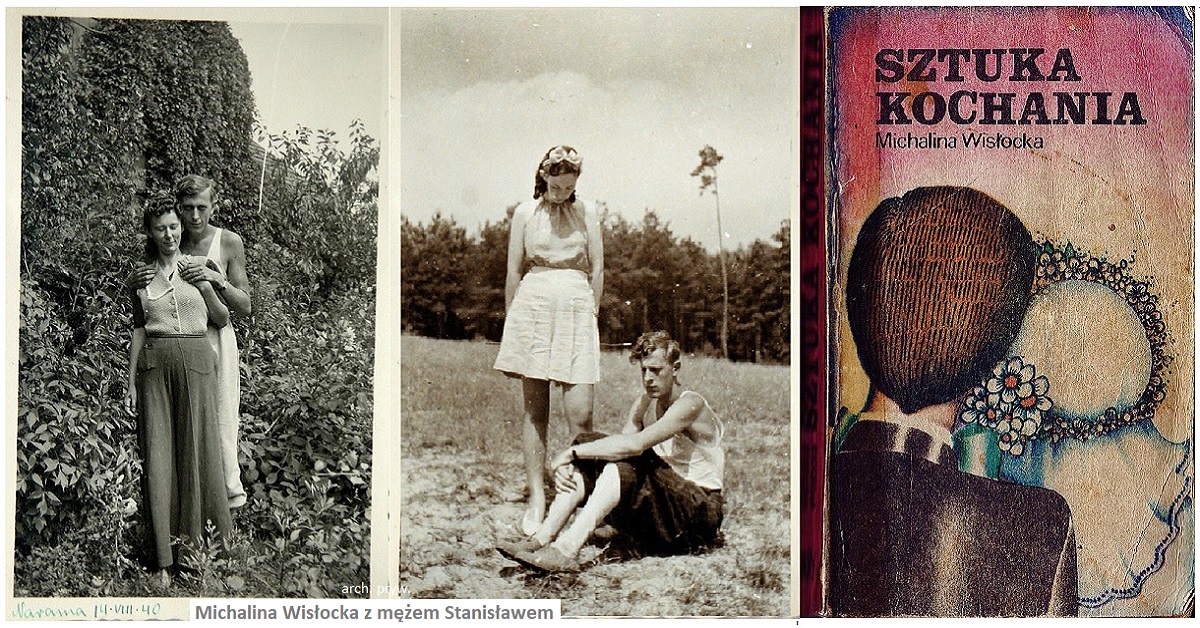
YES, THAT MICHALINA.
During the war, Jan Tymoteusz Braun was resettled to Narama, where he took the position of a teacher at the local school. Before the war, he had been a teacher and headmaster at Public School No. 30 on Wspólna Street in Łódź. His wife, Anna, gave Polish language lessons and managed the household. They had two sons, Andrzej and Jan, and a daughter, Michalina. In Narama, Jan lived with his wife and sons until the end of the war. Meanwhile, their daughter Michalina married Stanisław Wisłocki, a biologist, and moved with him to Warsaw, where they both worked at one of the city's hospitals. Michalina occasionally visited her parents and brothers in Narama, as evidenced by at least one signed photograph (and possibly another that also appears to have been taken in Narama). Yes, that's *the* Michalina Wisłocka—born on July 1, 1921, in Łódź, and passed away on February 5, 2005, in Warsaw. She was a gynecologist and medical doctor who became renowned across Poland as the author of books on sexology, particularly the popular science guide *The Art of Loving*, published in 1976, which left a lasting impression on Polish society.
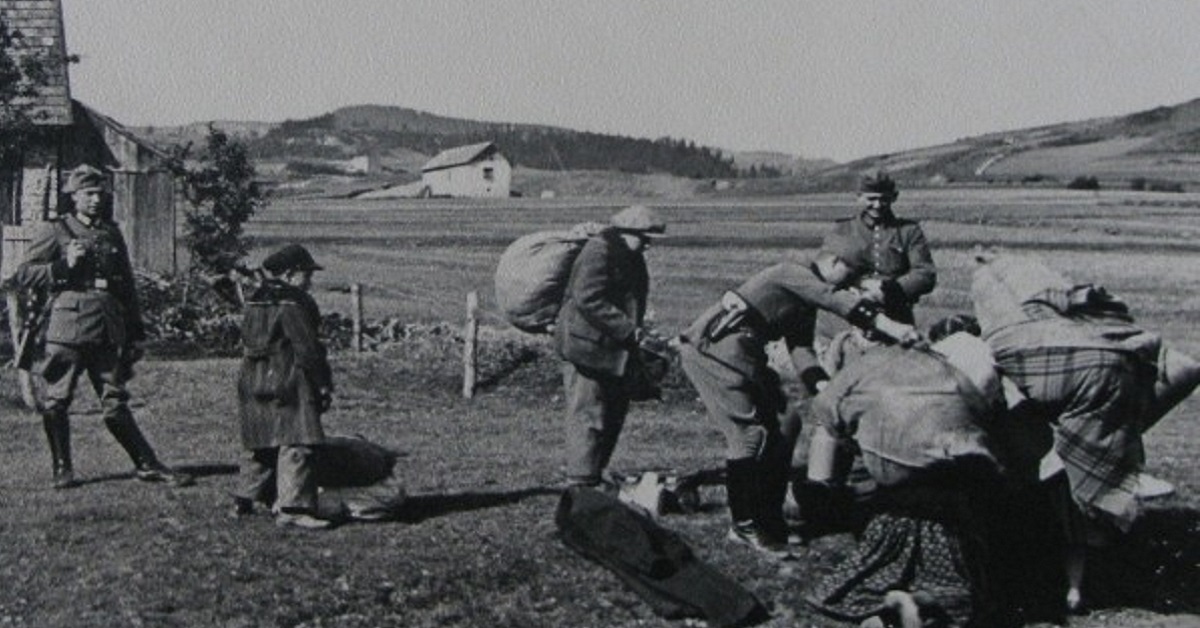
FROM RYCERKA GÓRNA TO NARAMA.
During World War II, among numerous criminal actions, the Germans carried out the so-called *Aktion Saybusch* (*Akcja Żywiec*). Between September 20 and November 12, 1940, approximately 50,000 residents of Żywiec and its surroundings were forcibly displaced to the territory of the General Government, while their homes and farms were given to German settlers. The forcibly displaced residents of Żywiec, stripped of their belongings and money, with only personal items in hand, were expelled from their homes and left to fend for themselves in the towns, cities, and villages of the General Government. A group of these displaced people ended up in the Miechów district, and at least one family found shelter in Narama. This was the family of Alojzy and Franciszka Ryłko from Rycerka Dolna, who found refuge in Narama during the war. They were hosted by one of the local farmers and had nine children. Two of these children, Czesław and Wiesława, were born in Narama during this difficult time.
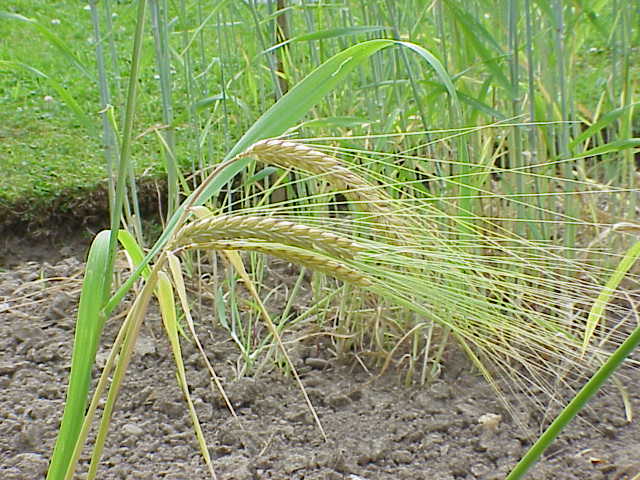

SPELT
Nowadays, few people may know this, but between the 16th and 18th centuries, spelt was among the grains cultivated in Narama. Spelt wheat (Triticum spelta L.), commonly called "spelt" or "spelt wheat," is a grain species belonging to the Poaceae family. Popular during the Middle Ages, it is rarely cultivated today. The term "spelt" is also used to refer to two-row barley (Hordeum distichon). (Source: Wikipedia).
Zbigniew Grzyb
